Lone Star Audio Fest 2018 Show Report
Volti Audio
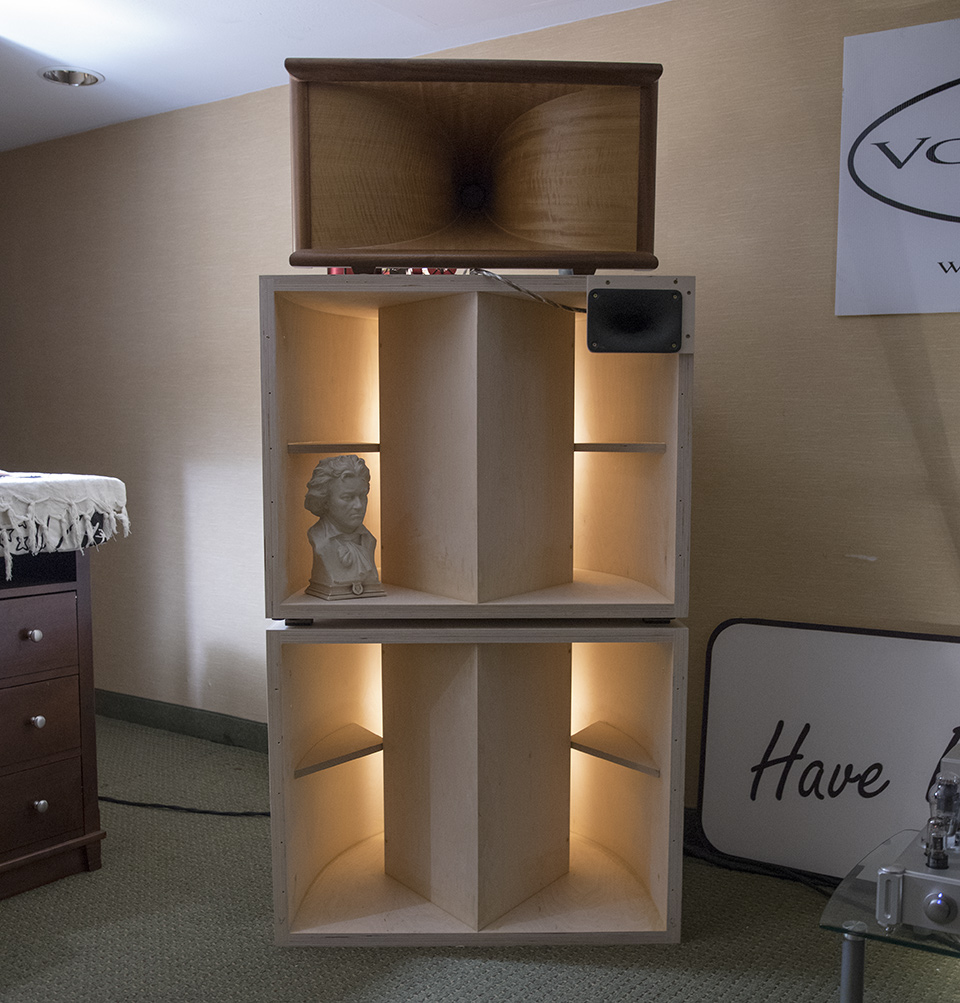
The amount of not give a fuck for the noise policy that went into effect over an hour ago is only rivaled by the aura of smug satisfaction coming from Greg of Volti Audio as he sat with a huge grin in the darkly lit room, feet kicked up on the coffee table, beer in hand.
While most people were either just unpacking or working out the acoustics of their rooms, one man was settling in for a relaxing weekend of drinking beer and listening to good music,
while setting the standard for the show - both in attitude and in sound.
This is Greg's first year at Lone Star, having been convinced by Dave of Raven Audio to attend this mixed bag of frat party like atmosphere and most knowledgeable and serious group of listeners in the country. After a wildly successful showing at AXPONA, where Greg had sold his entire stock of finished speakers. He figured this show would be the right place to cut loose with a pair of speakers nailed together from spare parts and old experiments. The result is a system that blows the doors off of expectations - including his own.
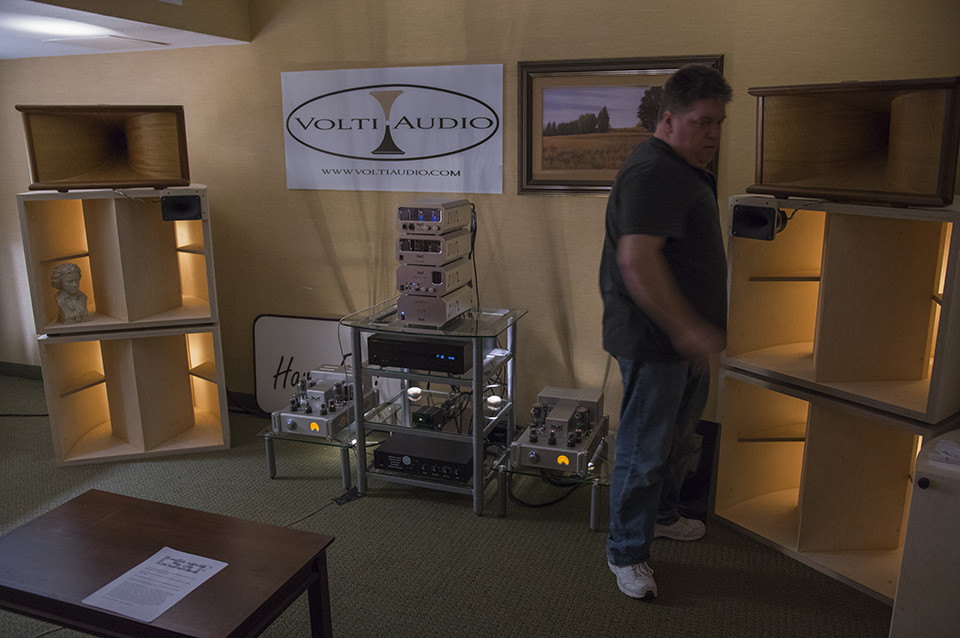
Greg prepared a perfect system for the over the top atmosphere of Lone Star. Stacking two unfinished bass cabinets from his Rival speaker, coupled with a pair of old Fc212 horns he had laying around, and created a monster system. The sensitivity of the speakers measured 109db/watt at one meter. I told Greg that the system reminded me of the JBL/Dynaco setup I wrote up years ago. Upon showing him a photo of the system he immediately was able to rattle off the make of the horn(which was a limited run DIY fiberglass unit) and said he had a pair years ago, and detailed a list of problems with the design.
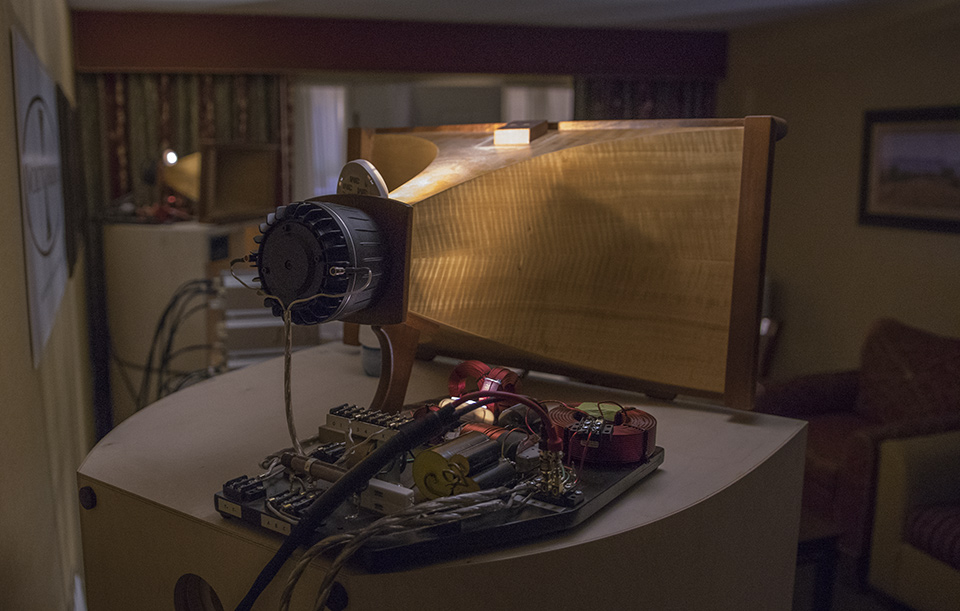
The hotel room is only 14'x12' and it is stuffed with speakers, tube amps, and most importantly, good sound.
Lots of good sound, I measured just north of 100dB from the listening position meaning the Raven Audio Tube amps were pushing around 0.5 watts to the system.
The overwhelming size of the image and the clarity of these super sensitive horns in this room was way more impressive than the volume level.
While Greg was quick to agree with me that the system was a little over done in the lower treble, a compromise of the thrown together system and a mid horn design that was not his first preference.
Despite the elevated treble there was zero harshness, and the distortion levels across the board were as close to zero as I could imagine.
Integration of the dual 15 inch woofer bass cabinets with the mid and treble horns was smooth and no other problems were audible.

On Sunday, the thrown together system of stacked bass cabs was replaced by a raw unfinished rat rod version of the Volti Vittora.
I told Greg that with all of the DIY guys at the show someone was probably going to ask if they could buy the bass cabs in raw unfinished form, he laughed and said he already had a couple of people try that.
While the ad hoc system he showed off previous days was the first to come out of everyone's mouth when I asked "What room did you like" to the fellow exhibitors and show goers, this speaker was something completely different.
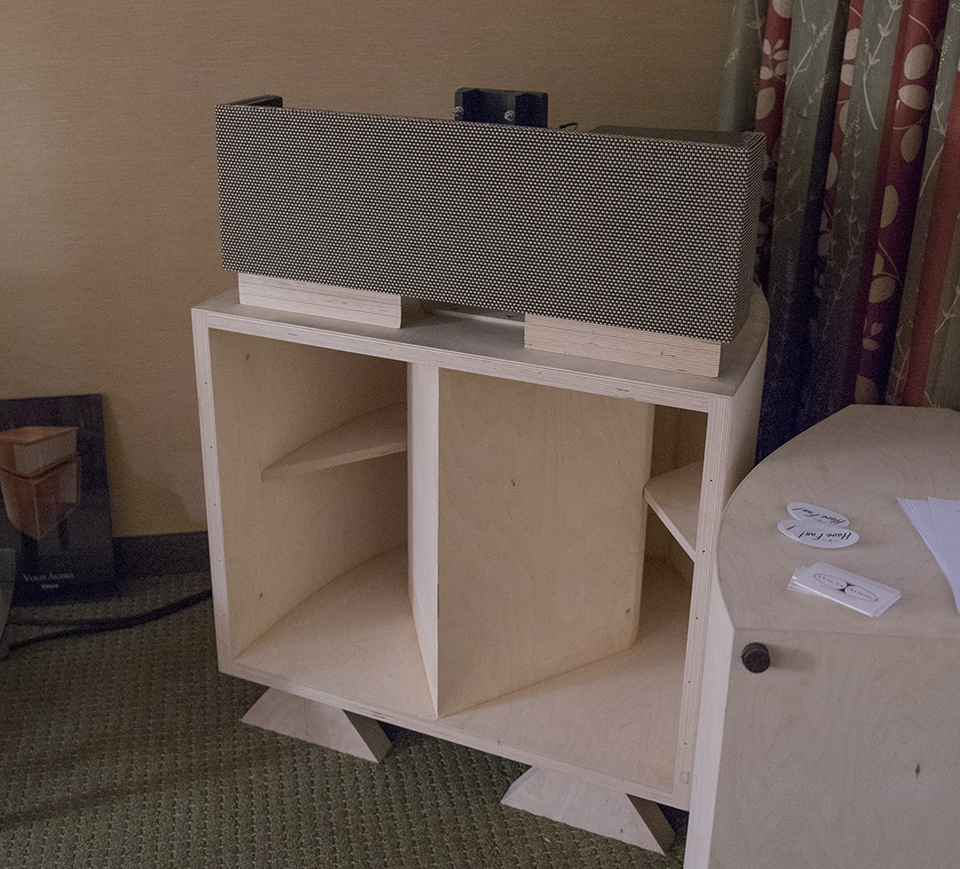
There was no signs of concern while replacing the most impressive system at the show with a proven product.
I watched as Greg went through his fine tuning and last minute rituals for setting up the new speakers, and when he was finally happy I was the first to get to sit in the listening position.
The sound from this system was silky smooth, something I've never heard from a horn based system. While the scale of the image was reduced without the double bass cabinets and larger horn, it was reduced to a proper scale where everything was a reasonable size and the imaging was wide and damn near perfect. Opposed to his vertical horn based system I heard at
RMAF 3 years ago, this speaker created a broad full experience that was definitely best from the listening position, but still enjoyable from other seats.
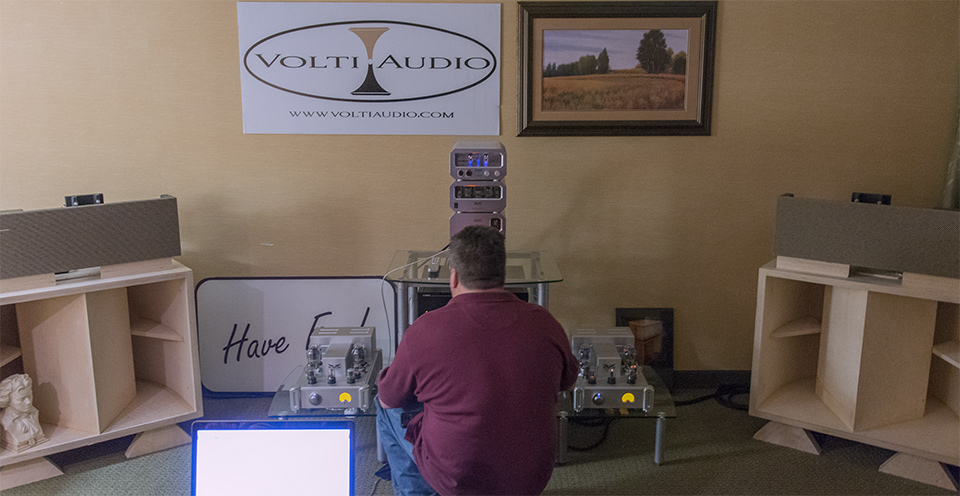
Shortly after I arrived Thursday evening, and before we had met, I overheard Greg at the bar lamenting what seemed to be an arbitrary age requirement to be taken seriously by some in the industry.
If you haven't been manufacturing for 15 years it's easy to get overlooked.
Well I am here to say that if you are into not just horn systems, but audio at all and ignore this man's work you are making a huge mistake.
The level of knowledge, experience from constant experimentation, as well as one of the best pair of ears I've had the company to critically listen with, puts him on a short list of people to watch.
While everyone may not be able to afford a pair of $26k speakers from Greg, you should be happy that he is pushing the limits of horn based systems and making some of the greatest sounding speakers to exist.
When it came time to leave Sunday morning Greg's last words to me were "I'll be back next year."
Rosso Fiorentino Siena
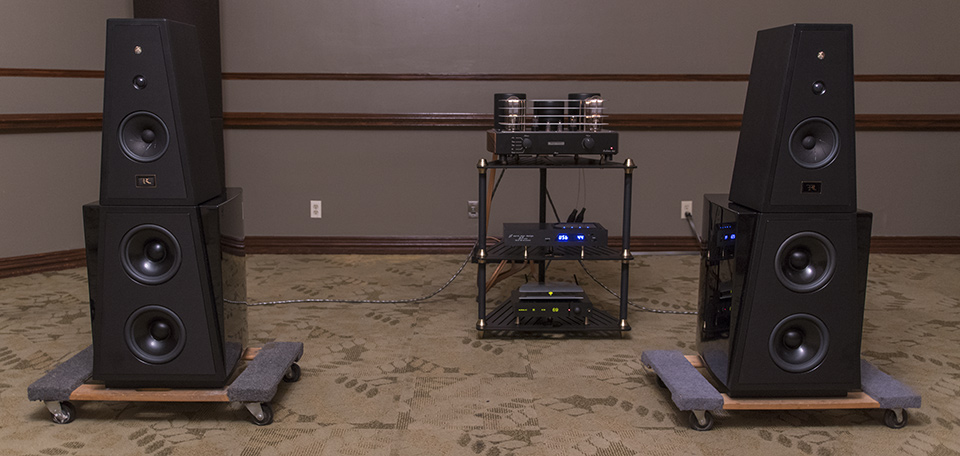
While sitting at the bar ordering my first what would be many Budweisers for the long weekend I was introduced to Skip.
He was looking deeply flustered and lamenting the room acoustics saying that he was going to abandon his large conference room for one of the smaller hotel rooms.
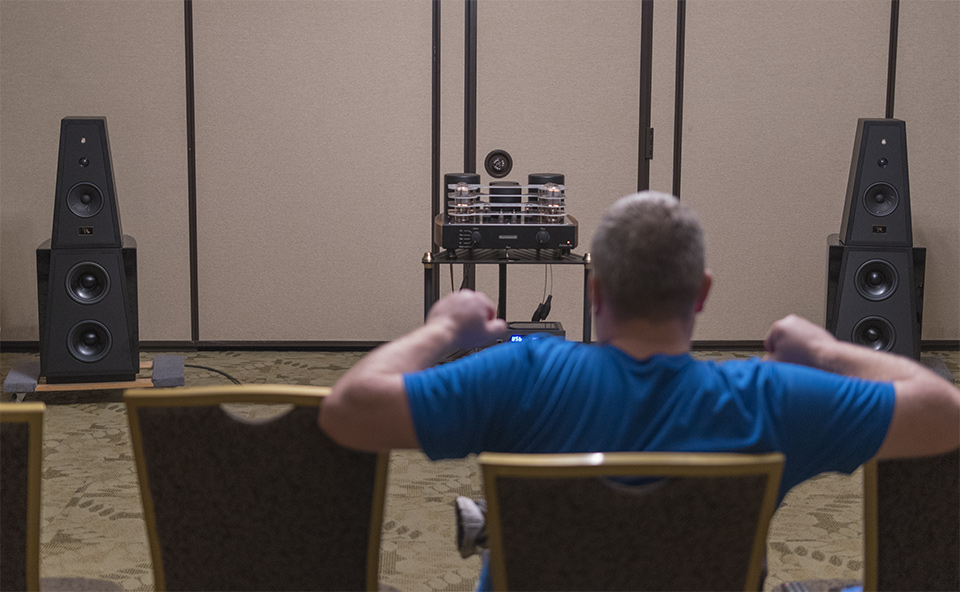
Showing up the evening before such a laid back event means you get to see how the sausage is made. I spent quite a bit of time with these speakers helping to set them up, listening, rolling them around the floor with these furniture dollies in one of the two large rooms occupied by the show. As such, I got a better idea of what they really sound like and how they work in different configurations than just about any of the other speakers at the show. All this rolling the speakers around is thanks to Skip, the owner of Audio Thesis, a local to the Dallas area hifi shop. Skip has been coming to this show since before he started his business. He is a true believer, and has three rooms at the show for different setups and brands he represents.
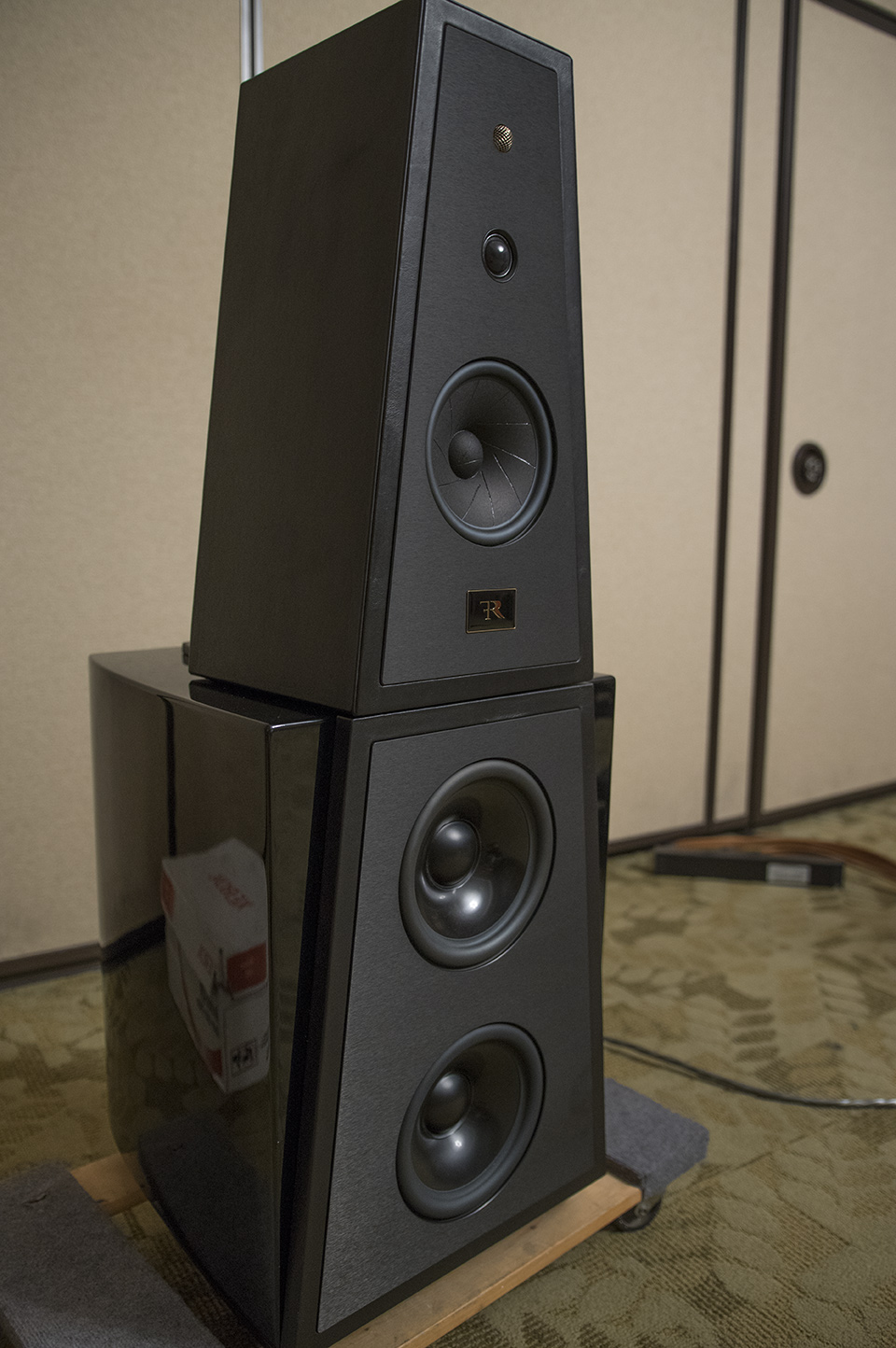
The setup had congestion issues at higher volumes, usually a sign that the room is overloading with energy(the reflected energy becomes loud enough to obscure the direct sound). The obvious culprit was the large room with three concrete walls and a partition. I suggested moving the speakers to have a partition behind them instead concrete - so it could act as an absorber for the sound coming from the direction of the speakers.
Only issue with moving the setup was the power cables Skip brought were not long enough to get to the outlet some 20+ feet away. I offered up a Home Depot extension cord I had brought in my bag of tricks.
The comedy of plugging thousands of dollars worth of power cord and conditioner into an orange 25 foot power cord was not lost on me, but I didn't rub it in too much.
After a some more shifting about we started getting some really good sound out of the room.
While he was happy with the improvement, he had problems with getting loud enough, even though I was measuring +100dB - I blame this on the ScanSpeak Revelator, it's just too smooth for it's own good.
The room stayed pretty much the same all Friday, but around 11pm I saw Skip pushing the speakers into the hotel elevator.
Unhappy with the compromises of the large room he was moving the setup to a standard hotel room, all in the pursuit of good sound.
While he may not have convinced me that these are the greatest speakers ever, there is no doubt that this guy is one hell of a representative for these brands.
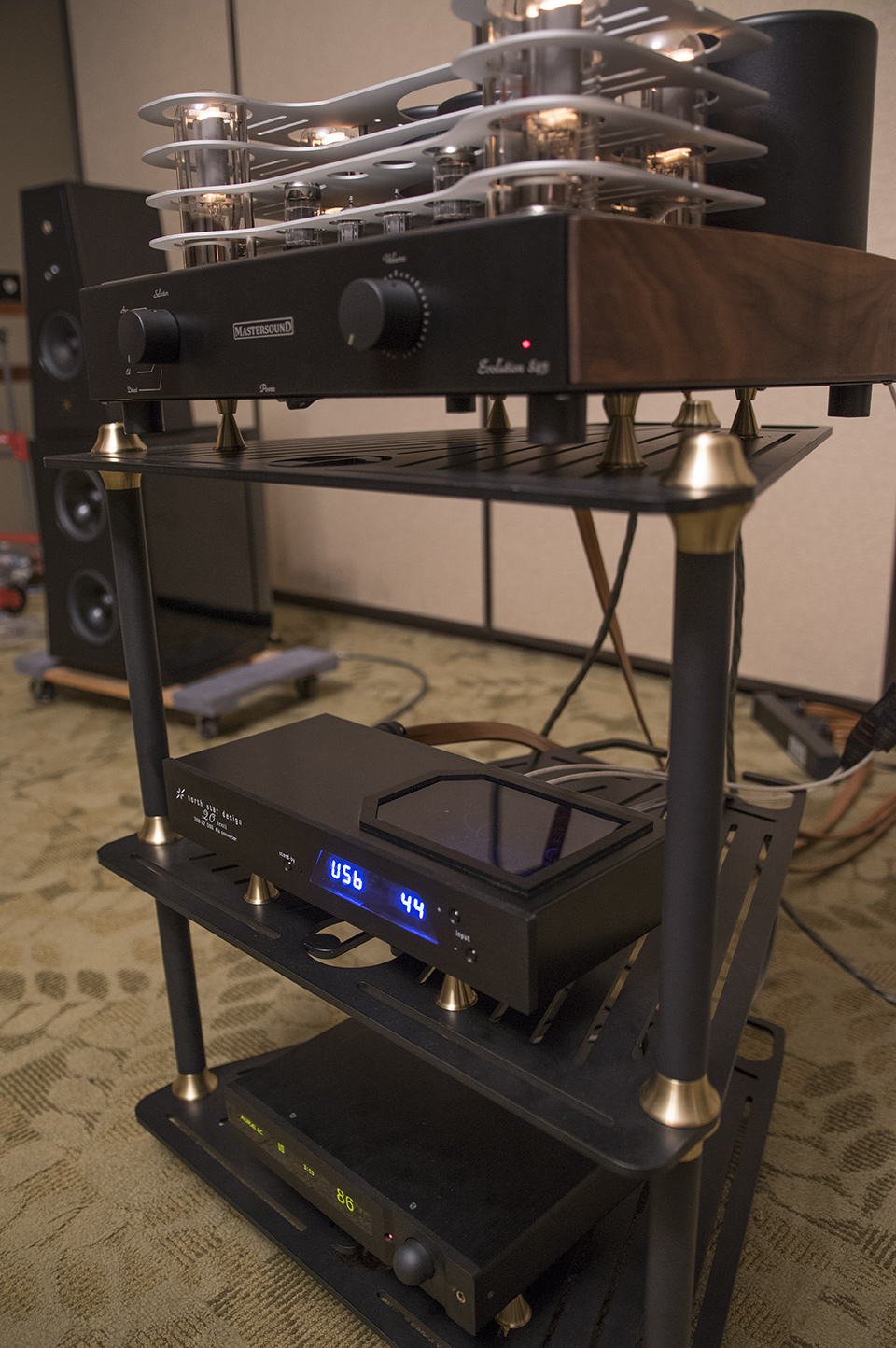
When I mentioned true believer I meant it in many ways. According to Skip these stands need a long burn in time to sound proper.
All of Skips rooms were running Mastersound tube amps, and I didn't hear anything but good performance out of them.
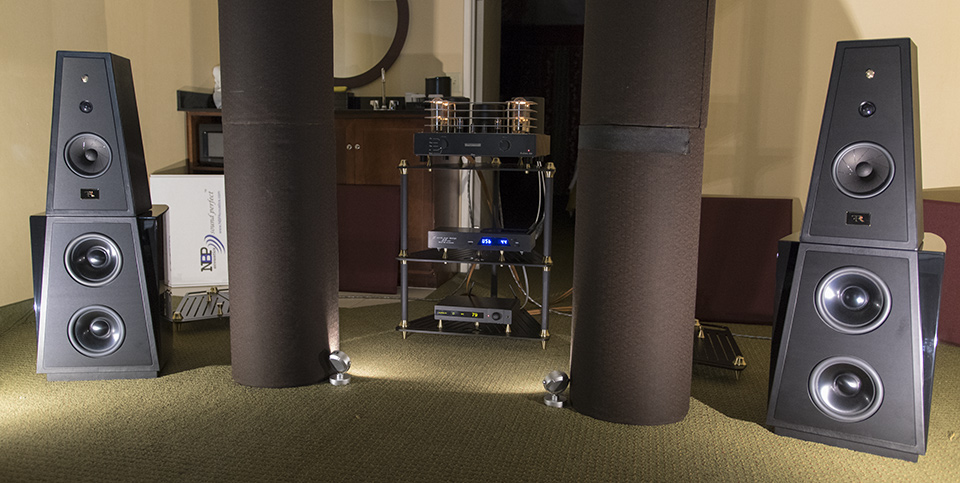
Here the speakers are in their final resting place, in a smaller 2nd floor room.
The Siena is one step below the top of the line from the Italian manufacturer Rosso Fiorentino. The baffle is a thick sandwich of aluminum that holds the Revelator woofer, dome tweeter, and super tweeter in place without any fasteners. The rest of the cabinet is made of high density fiberboard and is finished in a mixture of black leather and high gloss paint. The pair of 8 inch woofers are in a sealed alignment, but do a very good job of filling in the usual lower octaves.
The sound from these speakers is nonfatiguing and romantic - I am using this term technically to mean an elevated lower midrange. The driver choices seem solid and logical outside of the super tweeter which is supposedly handling information above 20kHz, which means your dog will probably appreciate its addition to the sound more than you.
The lower mid is the only coloration that I noticed, and the dispersion of the speakers is slightly more narrow than if a smaller dome tweeter and woofer were used.
Uilleam Audio / GR Research
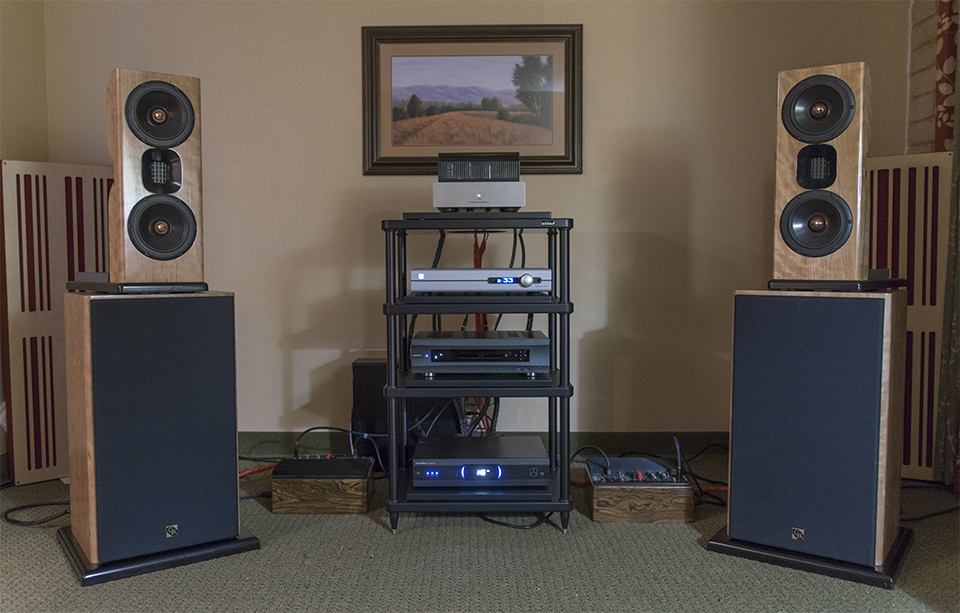
Time for some open baffle craziness. This set of speakers were designed by GR Research, and put together but Mike from Uilleam Audio.
Mike partners with DIY designers, and builds cabinets and crossovers based on provided specifications.
The Cabinetry was top notch and the build materials were equally impressive. I was involved with setting this pair of speakers up as well. We ended up cross firing the speakers to keep a solid center image across the listening seats. This involves pointing the left speaker at the furthest right seat, and right speaker at the left most. The open baffle dipole cancelation was more prevalent in this setup than from
Linkwitz Labs speakers I heard at RMAF.
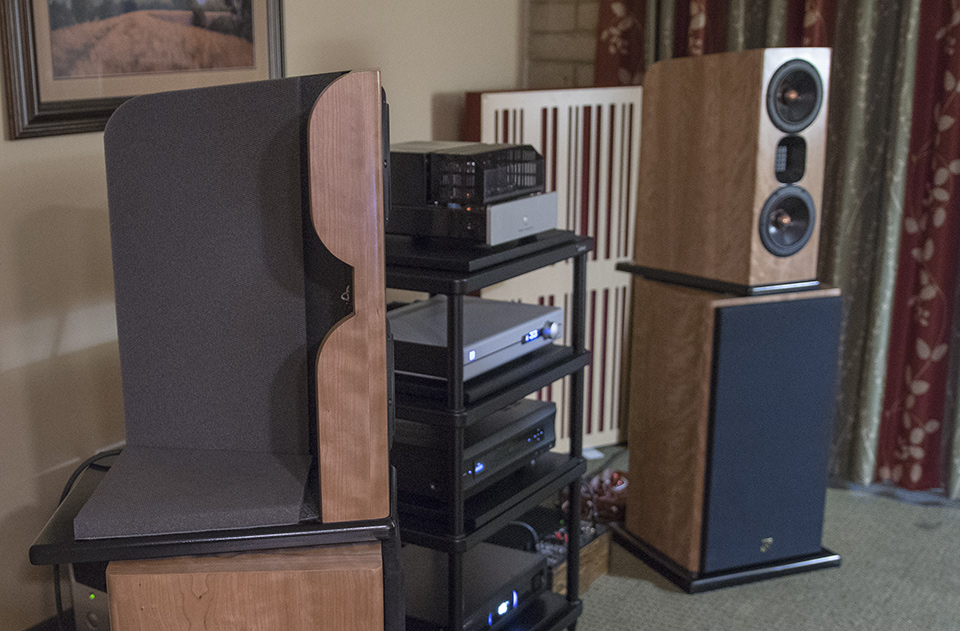
The bass is handled by a 2 pairs of Rythmik Dipole subwoofers, which are hiding behind the grill cloth. Every room at the show was fighting with modal issues from the solid concrete walls of the hotel rooms, and this room was no exception. The Bass was way over done initially, but with some deft tweaking by Mike he was able to dial it back and get a pretty well balanced sound from the small room.
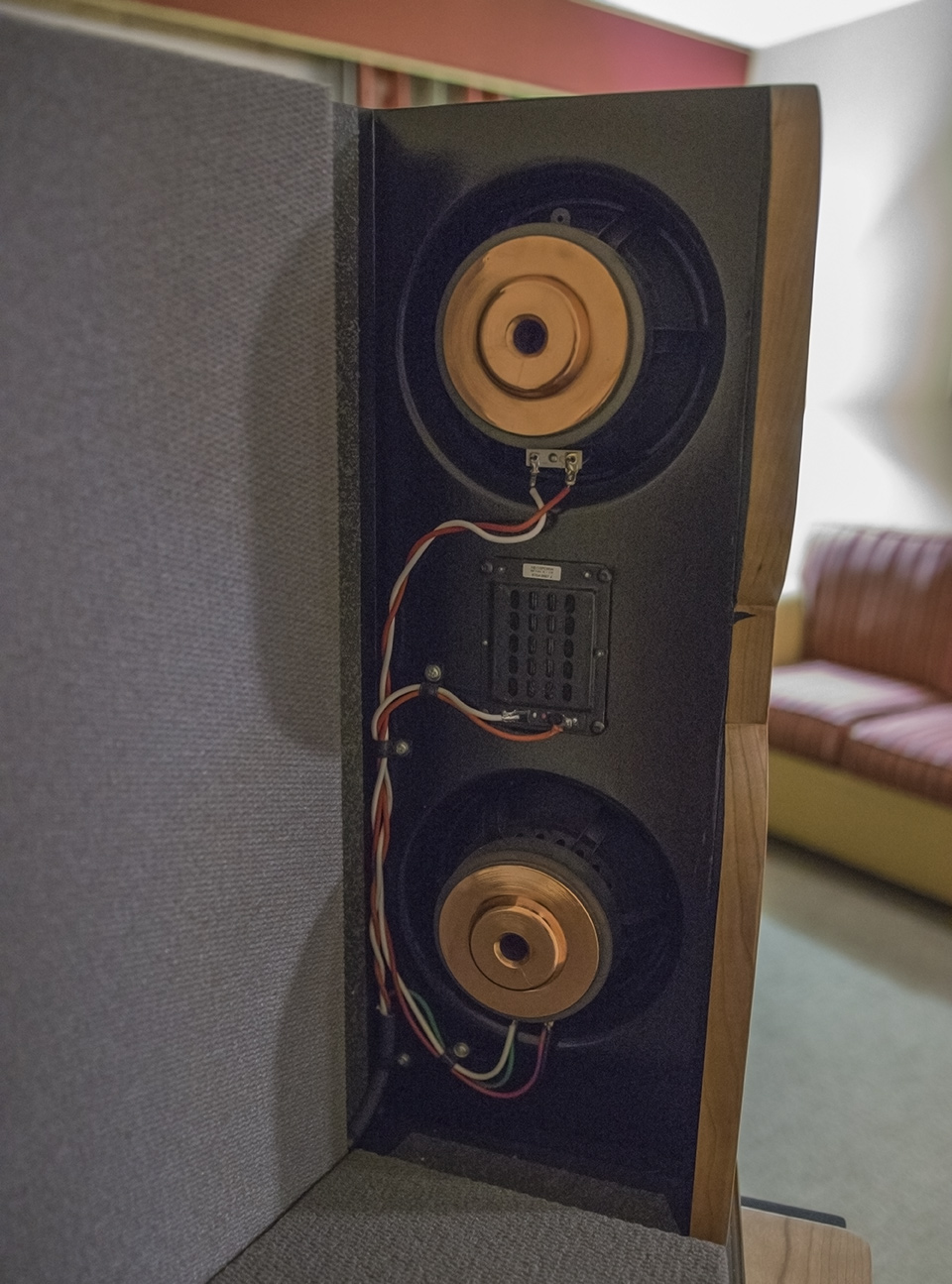
Back of the baffle shows some custom GR research woofers and the BG Planer driver that they are known for using. The sound absorption panel is usually used to dampening cabinets, but does double duty at softening the reflected wave from the "wing" on the speaker.
The resulting sound from this room was very involved.
The image was large, and three dimensional, as expected from an open back design.
I heard no issues with the speakers as far as comb filtering, cone breakup, or tonal irregularities. These are good speakers.
While I did not hear any magic from the subwoofers cabinetless alignment there was more headroom than required - which says plenty about the drivers given that they are canceling out most of their output.
Friday Morning Exhibitors Meeting
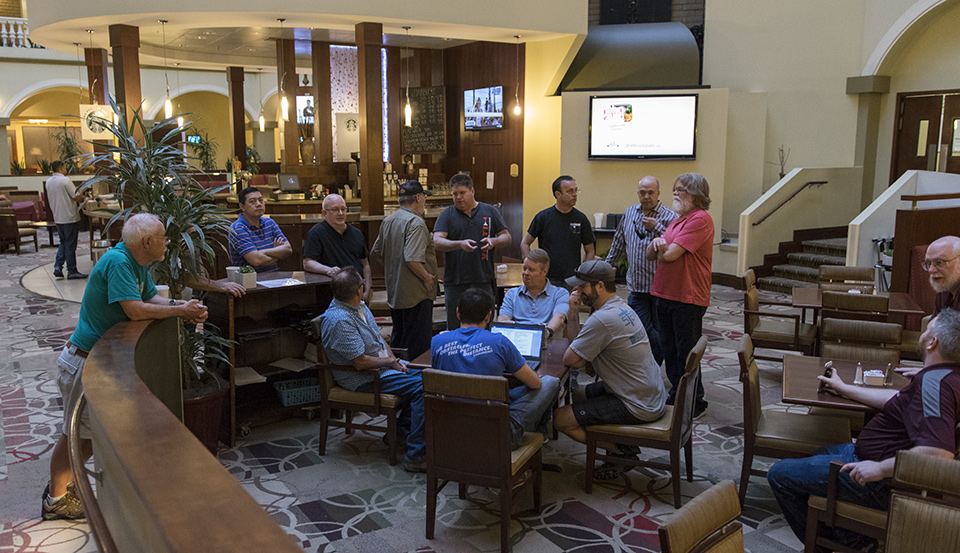
These are the guys that are making it happen, well at least some of them.
This most laid back of all audio shows doesn't keep regular hours, so Friday morning many of the manufacturer reps and presenters had not yet arrived.
When I say they don't keep regular hours, I mean it. There was no set schedule, but there were a few conflicting ones from past shows that visitors used to determine the best time to arrive.
While some showed up late, and many early arrivals had setup issues there was music at all hours of the day and night coming from rooms as they got setup, celebrated getting a good sound, or just relaxed.
While I'm sure the Reps at RMAF and other audio shows love audio, there is something special about this group. Many are DIY builders, or just guys bringing their personal systems. These people are the hardest of the hardcore, and the most inviting group I've experienced in the hobby - there is nothing bad to say about any of them. Now for their speakers, I'm sure I'll have a few things to say that might be negative, but these guys will take the opinion, and either use it, or put it in a pile with the rest of the shit they don't care about.
PureAudx Vivo

These guys came out of nowhere. PureAudx a small start up, and I'm not sure if they have any dealers yet. The sounds here were some of the best of the show.
The Vivo had a great smooth, but not exciting solution to the audio reproduction problem. The imaging was good, tone was perfect, and distortion levels, while not as low as the horns at the show, were on par with most of the cone and dome guys. If you are looking for a primary speaker system, this type of speaker is the kind you should be buying - a good speaker that does nothing wrong and nothing strange. Oddities are best kept for special occasions after a baseline good system is nailed down. With a smooth neutral response you can be assured that no matter what you play, it will sound good. I told these guys as much and they wanted to give me a high five and asked for a video testimonial. While I declined giving a testimonial, I can definitely recommend this speaker.
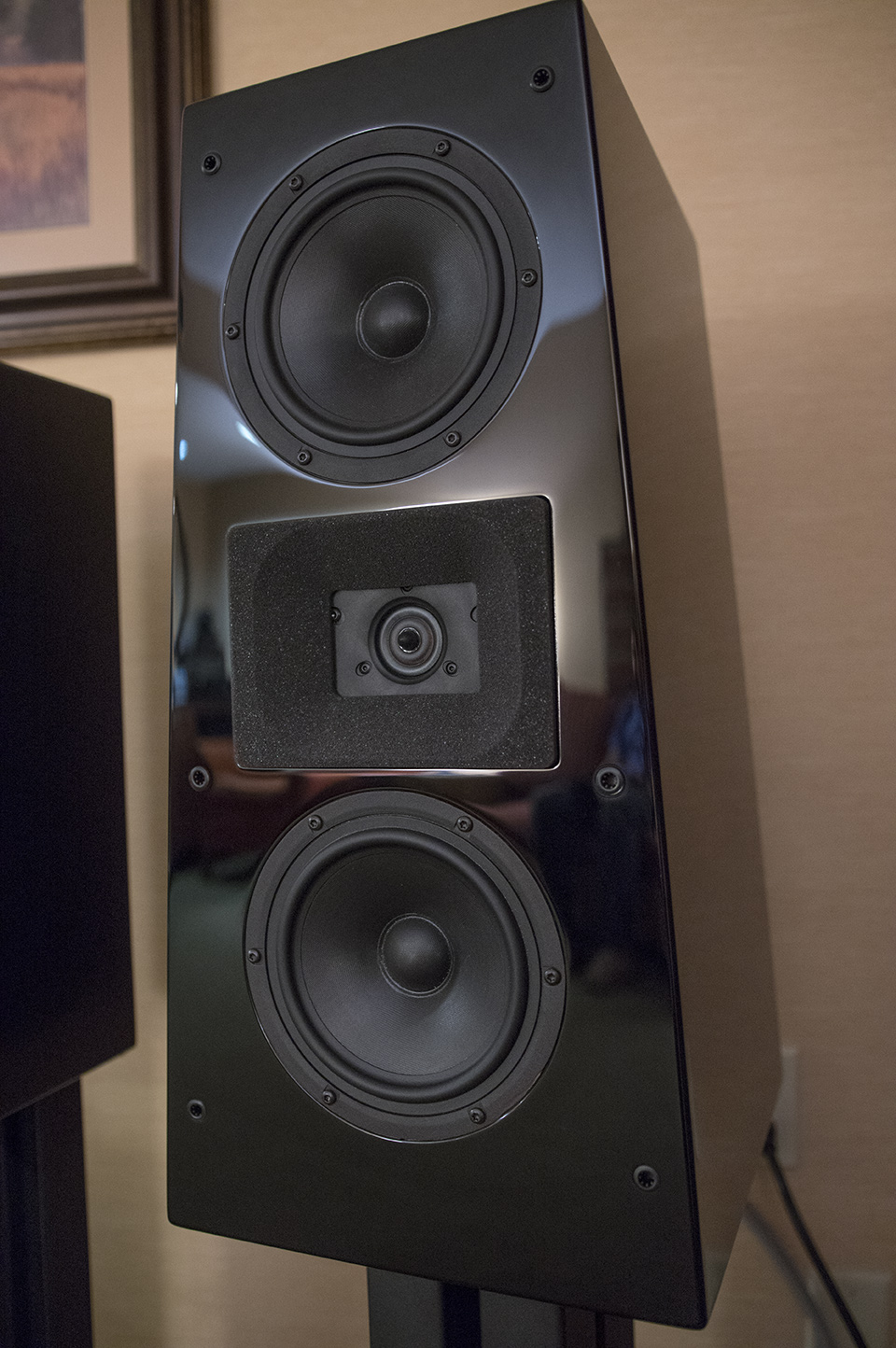
You can see the absorption around the ring radiator tweeter. There is just enough to take care of diffraction while avoiding the problems I've heard from many Wilson Audio setups that use thick felt around the tweeter.
Over damping the initial baffle bounce of the tweeter can lead to a situation where you can close your eyes and point directly at the tweeter no matter the song or placement.
I've heard from Wilson owners that adding lots of diffuser room treatment can help with this problem, but that has not been my experience.
The baffle shape is also a solution to the diffraction problem. The variable width of the baffle will spread, but also smooth out corner diffraction effect found in normally shaped boxes.
I hesitated to like these speakers as much as I did because of the center to center distance on the MTM configuration. I've recently been doing deep dives into the research and simulation of MTM's to control vertical dispersion.
On paper I'm sure there would be lobing issues from the configuration used in the Vivo, but try as I might putting my ear 1 foot from the speaker and moving off axis vertically I could not hear any such issues.
While it may be possible that one woofer is crossing over lower to avoid lobing and take care of baffle step, it is also possible that I've still got lots to learn about the implementation of MTM's and lobe steering in real world scenarios.
Pi Speakers
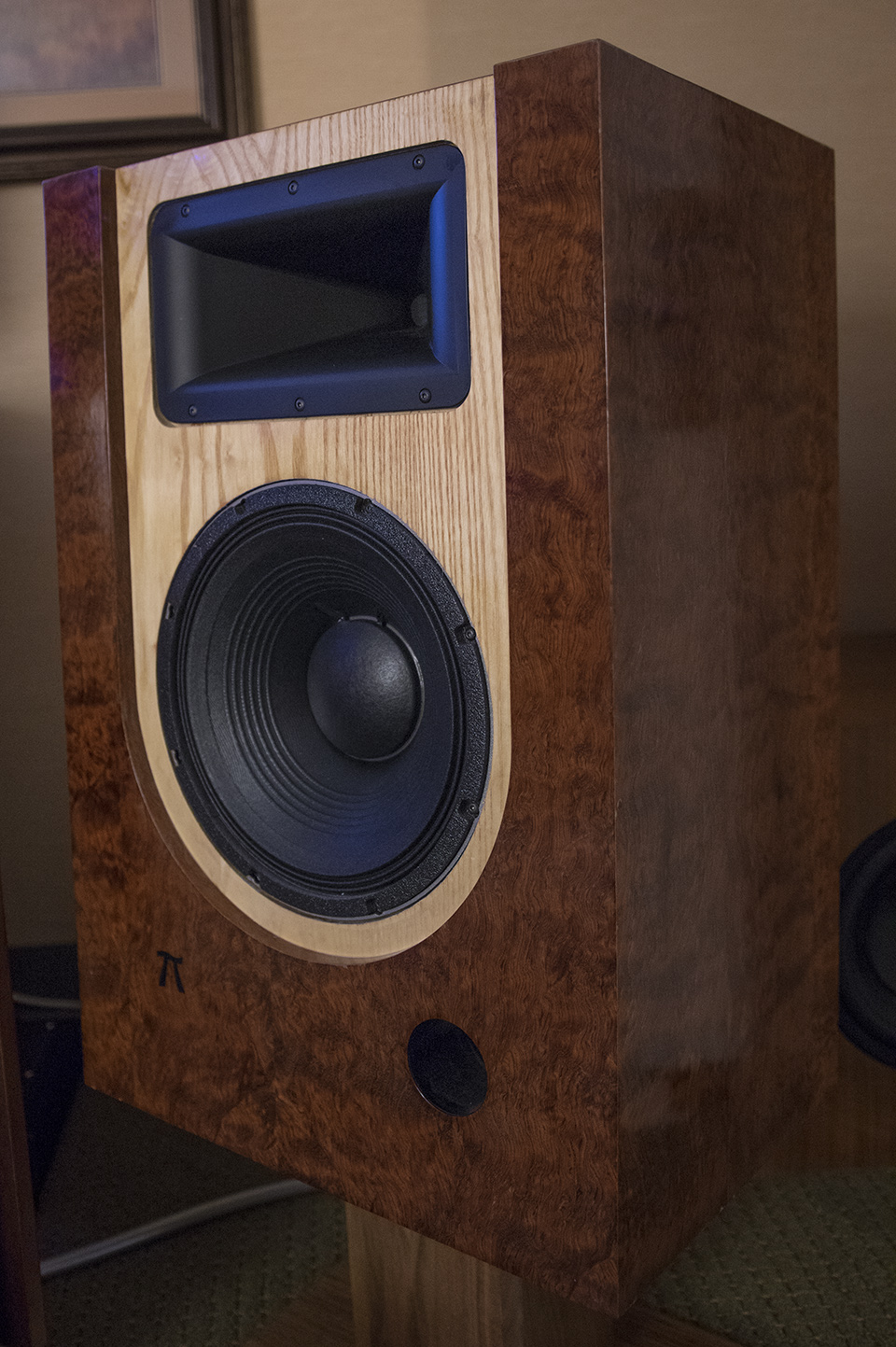
These are the little horn speakers at the show, which reflects the level of absurdity horns guys reach when left to themselves.
Wayne from Pi Speakers, a show veteran, and is one of the guys than makes this show happen every year. As such he is well versed in setting up the speakers for the concrete walled rooms that gave others so much trouble.
He played his experience off, giving credit to the speakers and multiple subwoofer setup but, Friday morning he was one of only a handful that had a sound worth sharing.
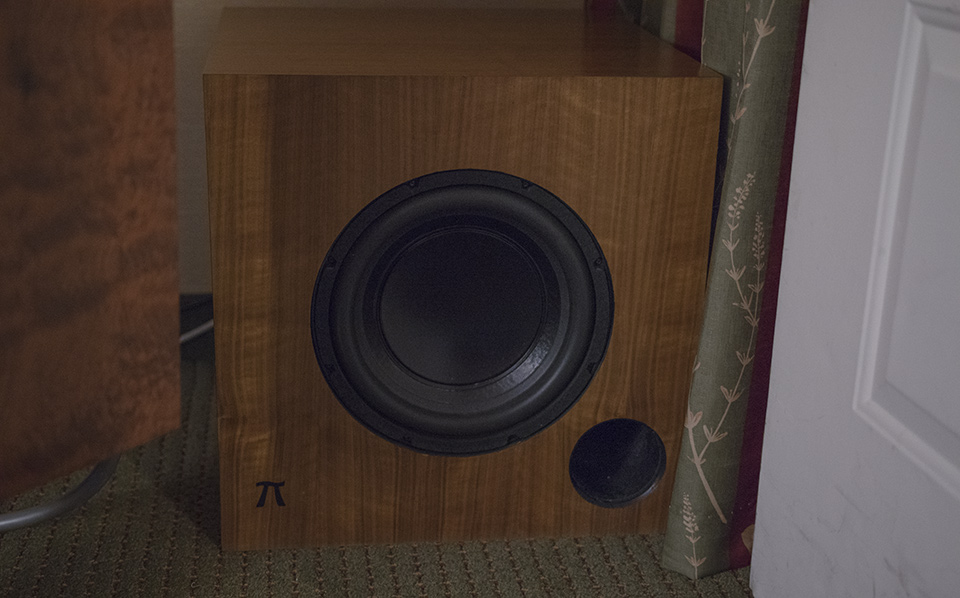
The Pi system is something I ran into years ago when researching subwoofer swarms and multiple sub solutions to room mode problems. The impressive part of this system is how well integrated it was, I didn't notice the subwoofers at all audibly - the true measure of success for a subwoofer system.
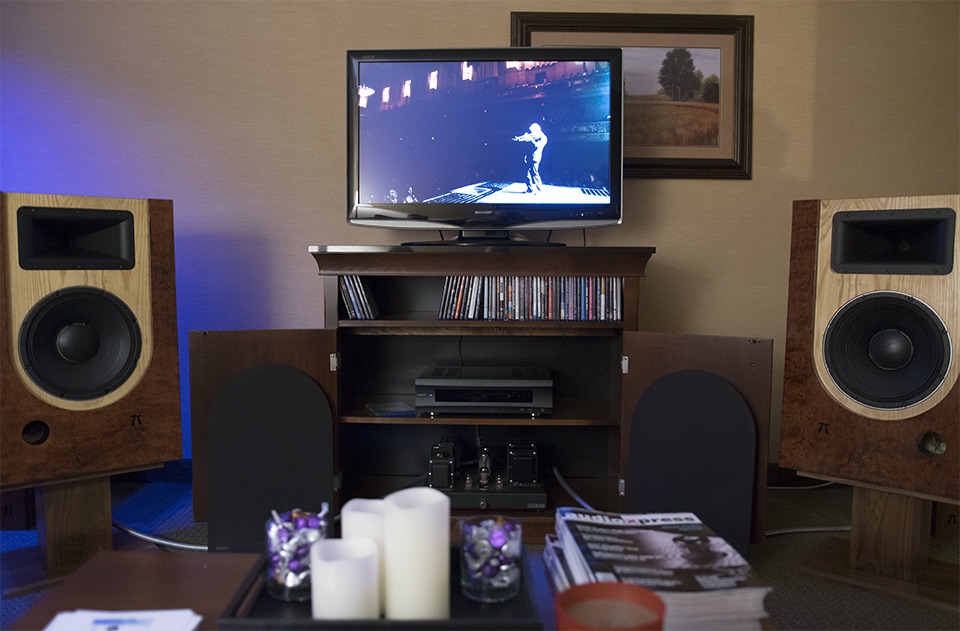
These are the only guys to hand out a frequency response graph with the literature. The graph looks good with controlled directivity starting around 1kHz, a little high for a large horn, but much more controlled than a dome tweeter based solution. The response has a bit of a dip between 4Khz and 8Khz, giving the speakers a very relaxed sound, without being overly warm or losing out on much detail.
Tekton Double Impact
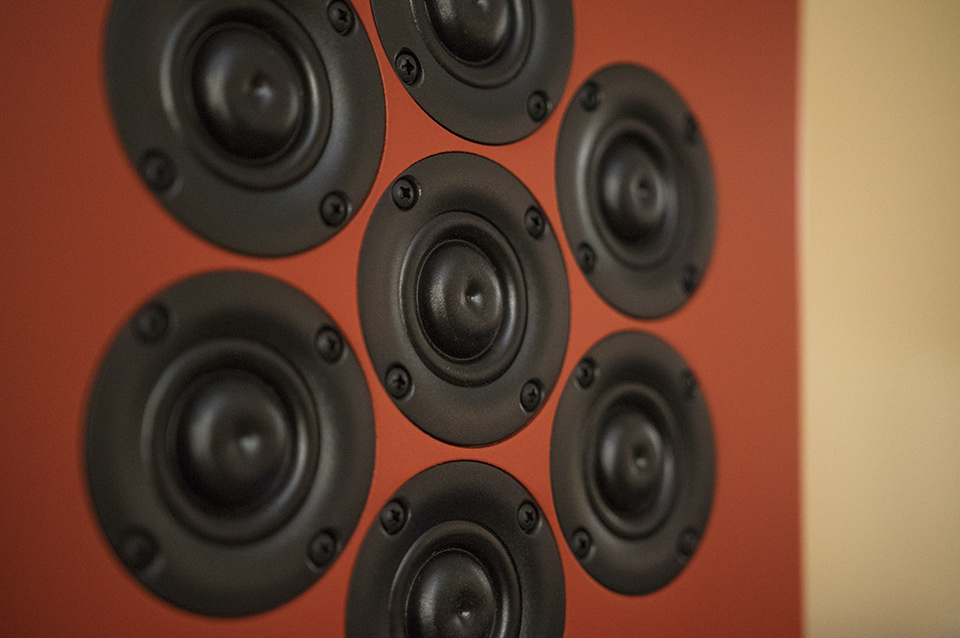
I finally got to hear what has been the buzz of the audiophile community for quite some time. The Tekton Double Impact is a large speaker with lots of drivers for relatively little money. 22 drivers for 3k in a pretty nice box is a hell of a deal... if they sound good.
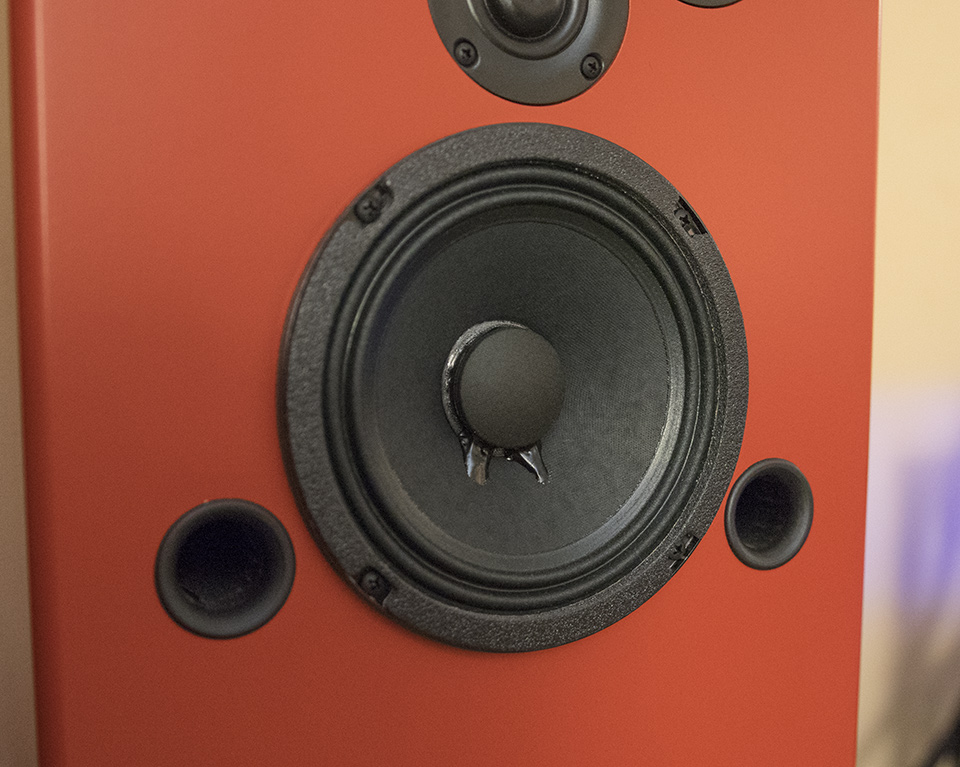
Well, they sounded great from the listening position. I walked the room quite a bit listening for the tell tale signs of comb filtering from the tweeter array that should be happening... and I did hear it, but it was less peaky and nasty than anticipated. A compromised solution for sure, but the real problem with these speakers is not the tweeter array, it's the center to center distance for the midrange drivers. There is a relatively strong tonal shift when moving off axis, and it does not feel like it matches the tweeter array in directivity meaning it's not a uniform roll off. Still, as long as you plan on sitting while listening or drinking heavily while dancing in front of them, these are a hell of a good sounding speaker.
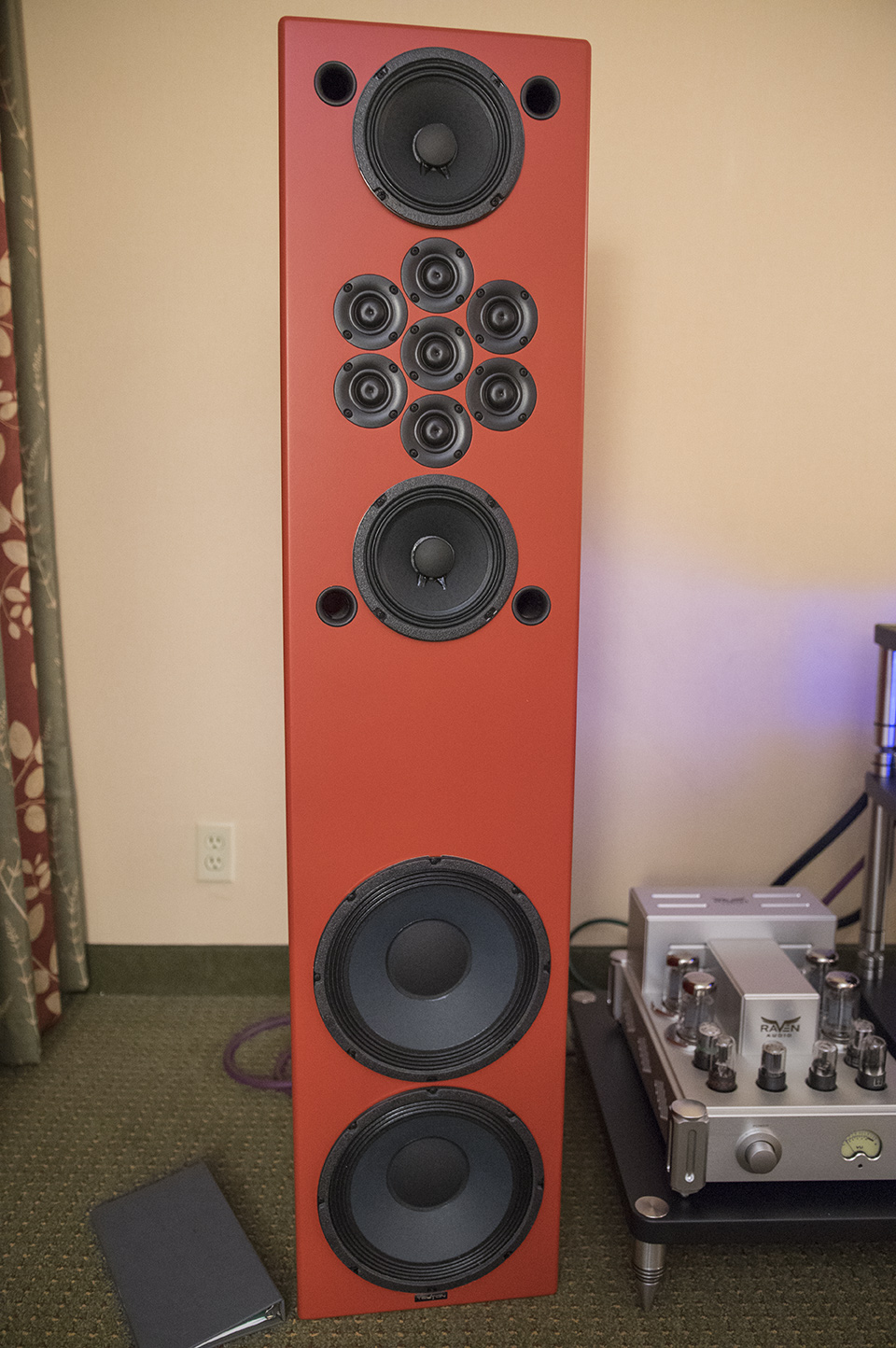
The speakers were driven by a Raven audio 30 watt per channel integrated tube amp, and sounded full without any headroom compromise. While I didn't hear any tones below 45Hz from the program material, the bass that was there is a little heavy handed, and I imagine in some rooms you might want to plug the ports for close to wall placement. On the other hand, if you are a bass head you are still going to want a subwoofer regardless of the size and quantity of the woofers on this speaker.
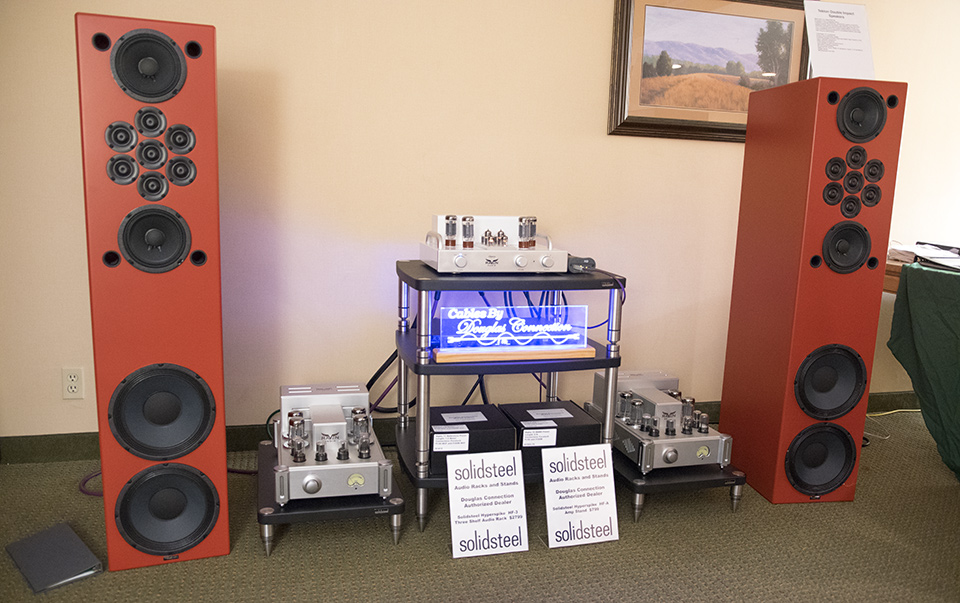
The only really nasty bit of this speaker is the visible tinsel leads on the midranges, but I can understand using this prosound based midrange, because there is almost no midrange available on the market without completely compromised sensitivity from the standard hifi drivers parts catalogs.
Legacy Audio Focus SE
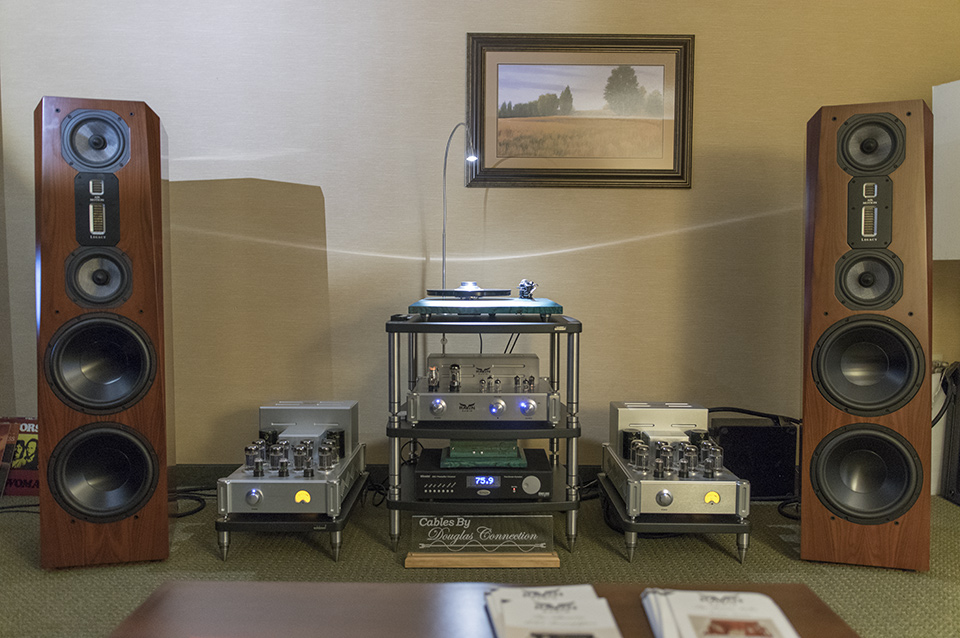
I did not like these speakers, the treble was peaky and in your face. The concrete walls of the hotel rooms, while great for containing sounds did not do these speakers any favors.
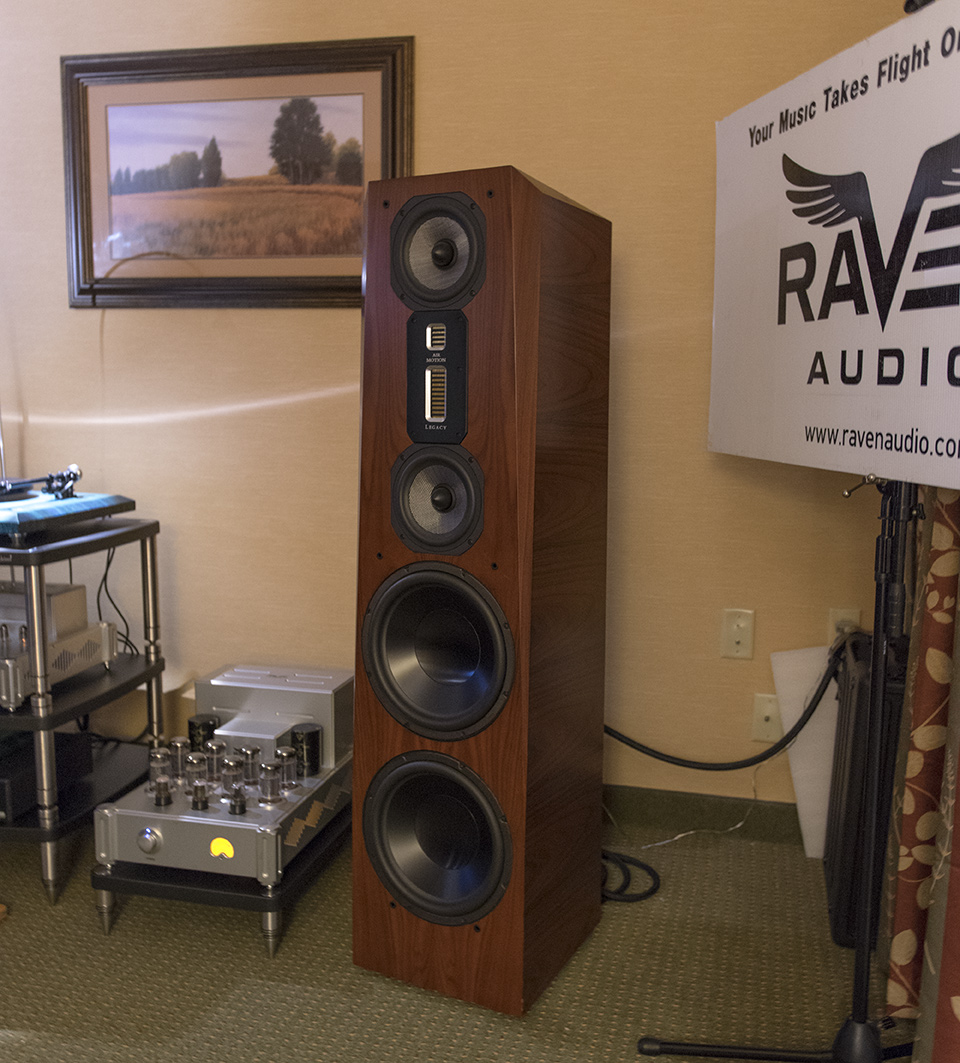
Another set of Raven Audio Monoblocks, and preamp gear. These tube amps did a hell of a job in every room I heard them. Zero hiss from 109dB sensitivity horns with the volume knob turned up - not an easy task for any amp. The bass performance and black background they provided for the speakers on display was impressive.
Austin Acoustics

A monster setup that was the talk of the show. Opinions were all across the board, with most of the diy guys rolling their eyes at the price tag, which kept climbing hyperbolically in discussions as the weekend went on. High prices do not bother me in the slightest - people can buy or sell whatever for however much they want. The hobby is about aesthetics and ritual as much as it is about sound, and there is no price limit you can put on aesthetics, or ways to achieve a spiritual zen with your music.
Everything here is handmade, from the tube amps, to the motors on the drivers. The only things sourced are the driver diaphragms, cones, baskets, and the active crossover, which has been heavily modded. The system is a fully active 4 way, meaning custom 8 hand built monoblock tube amps power the beast.
My take on the sound coming from this room is that the midrange is superb, the treble is over done, and the bass, while room dependent was a bit mushy.
Over all a pretty good showing for system made by and for one man.
Selah Audio Desktopia
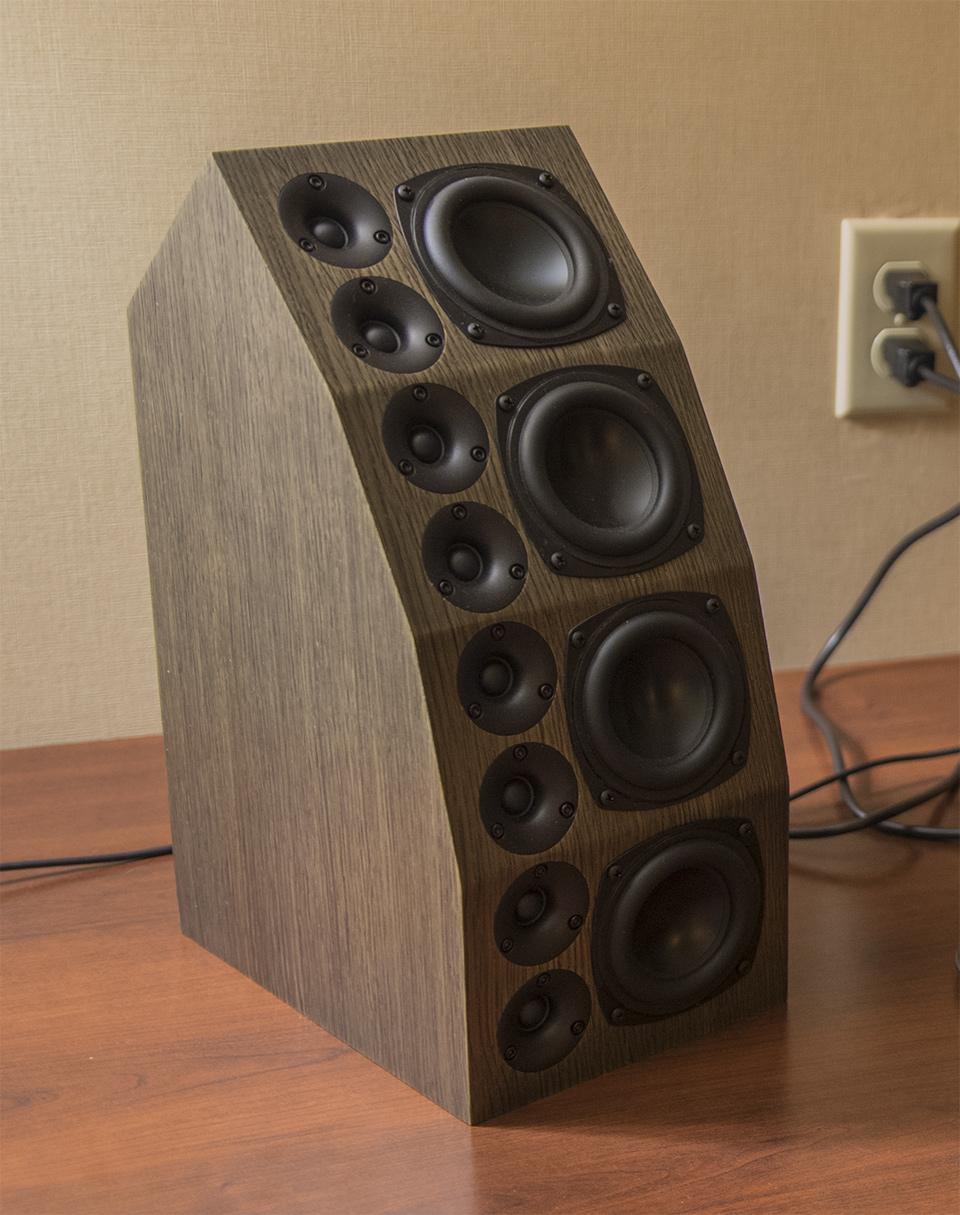
Rick from Selah is the reason I'm at this show. He let me know 2 days in advance that he would be here, and after checking prices I started packing my bags for the 300 mile trip.
Desktop versions of a CBT line array is something I have had rolling around in my head since the day I heard of the CBT design.
I own a previous iteration, which is much smaller and uses four 2 inch full range drivers in a 90 degree array.
My little speaker has limitation due to size, and lack of a real tweeter, but still does some neat things.
In comparison, the Desktopia from Selah uses four 3.5 inch drivers and 8 little horn loaded tweeters, powered by a MiniDSP plate amp which handles the crossover. All shading of the array is handled by resistors. While the woofers are only a little larger, the height of the array is nearly double at 14.5 inches.
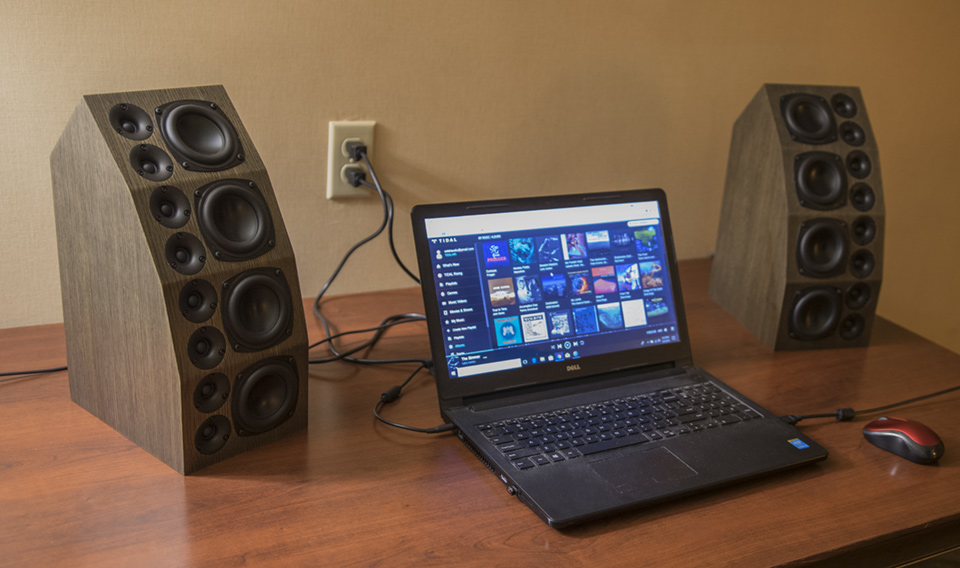
While vertical lobing was a concern for the center to center distance of the tweeter, I could detect no issues there, or for the woofers.
One issue that I didn't expect, but did hear was the horizontal lobing related to the crossover between the tweeter and the woofer.
This is the same effect that you would get if you placed a traditional speaker on its side.
The effect was distracting and ended up being a deal breaker for me personally. While the CBT did a great job of removing the effect of the desktop surface reflection, and instead took advantage of it, and allowed for vertical and front to back movement without tonal change, even slight horizontal movement brought about a big tonal changes.
Counter intuitively, I think pushing the crossover up as high as possible might help hide the horizontal lobing, putting it in a frequency range that is not as obvious.
Selah Audio Epico
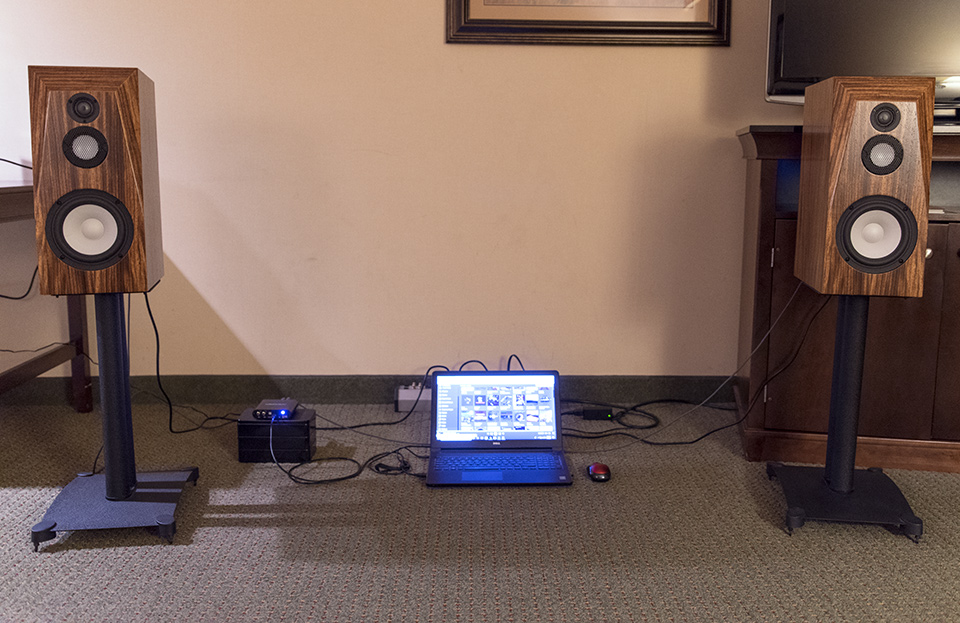
While the Desktopia was more of a science experiment, the Selah Audio Epico is a known good format. Take some of the best drivers available, put them in a pretty box, and add crossover and amplification.
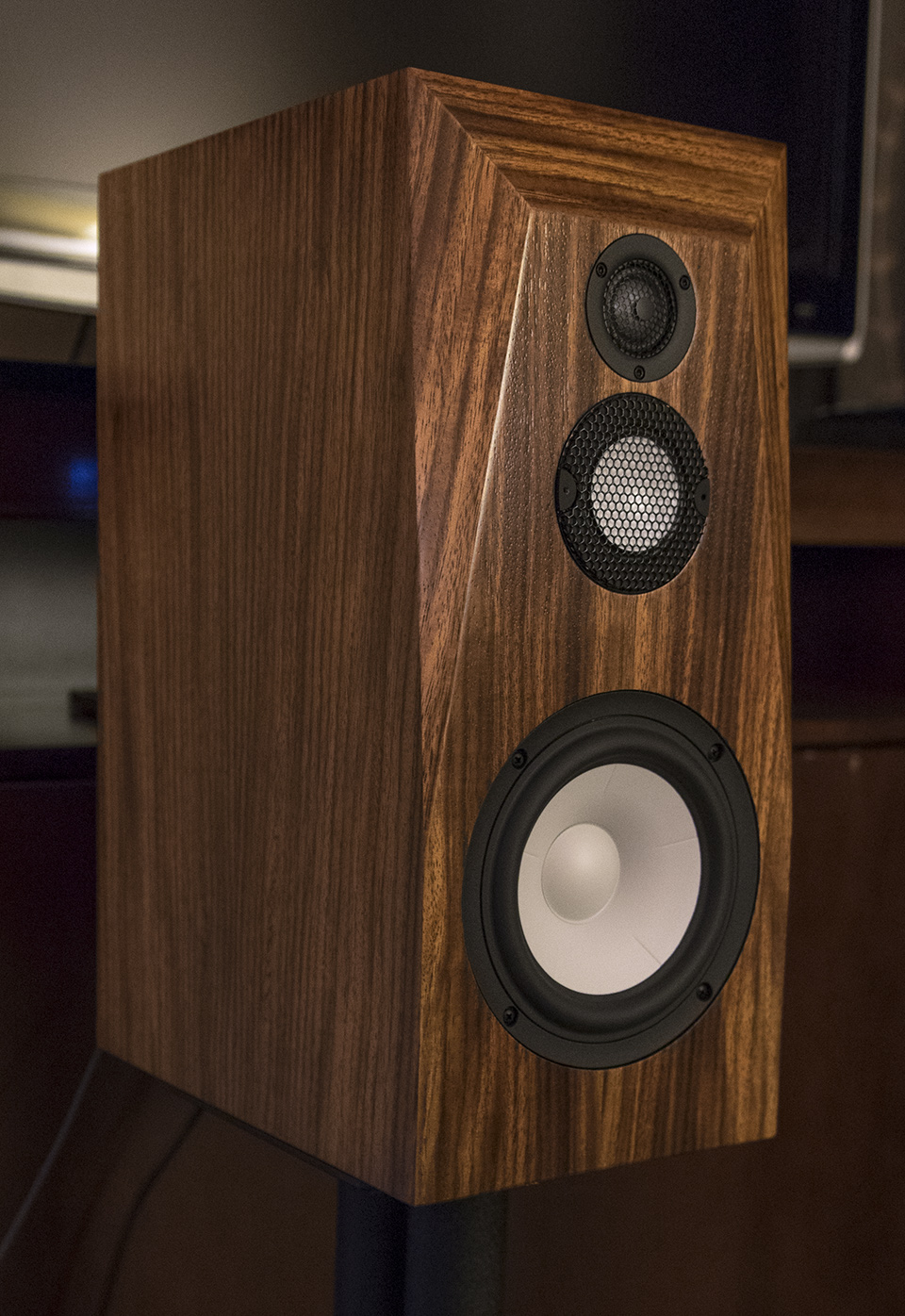
The top shelf drivers used here include the beryllium dome tweeter from ScanSpeak, Accuton's 2 inch ceramic midrange, and the new SB acoustics 6 inch ceramic woofer.
I started off with listening to some of my favorite tunes with such hits as Earth, Wind & Fire's Let's Groove - much to Rick's dismay.
The speaker did the job of sounding good. Extremely clean drivers, no hint of cone breakup, and smooth bass extension with no compromises. Only issue I could detect is that the level of the midrange was slightly elevated, making the speaker sometimes sound more like a full range speaker that had a tweeter and woofer for support. In my opinion, a 1dB to 1.5dB cut to the midrange level would balance out the sound.
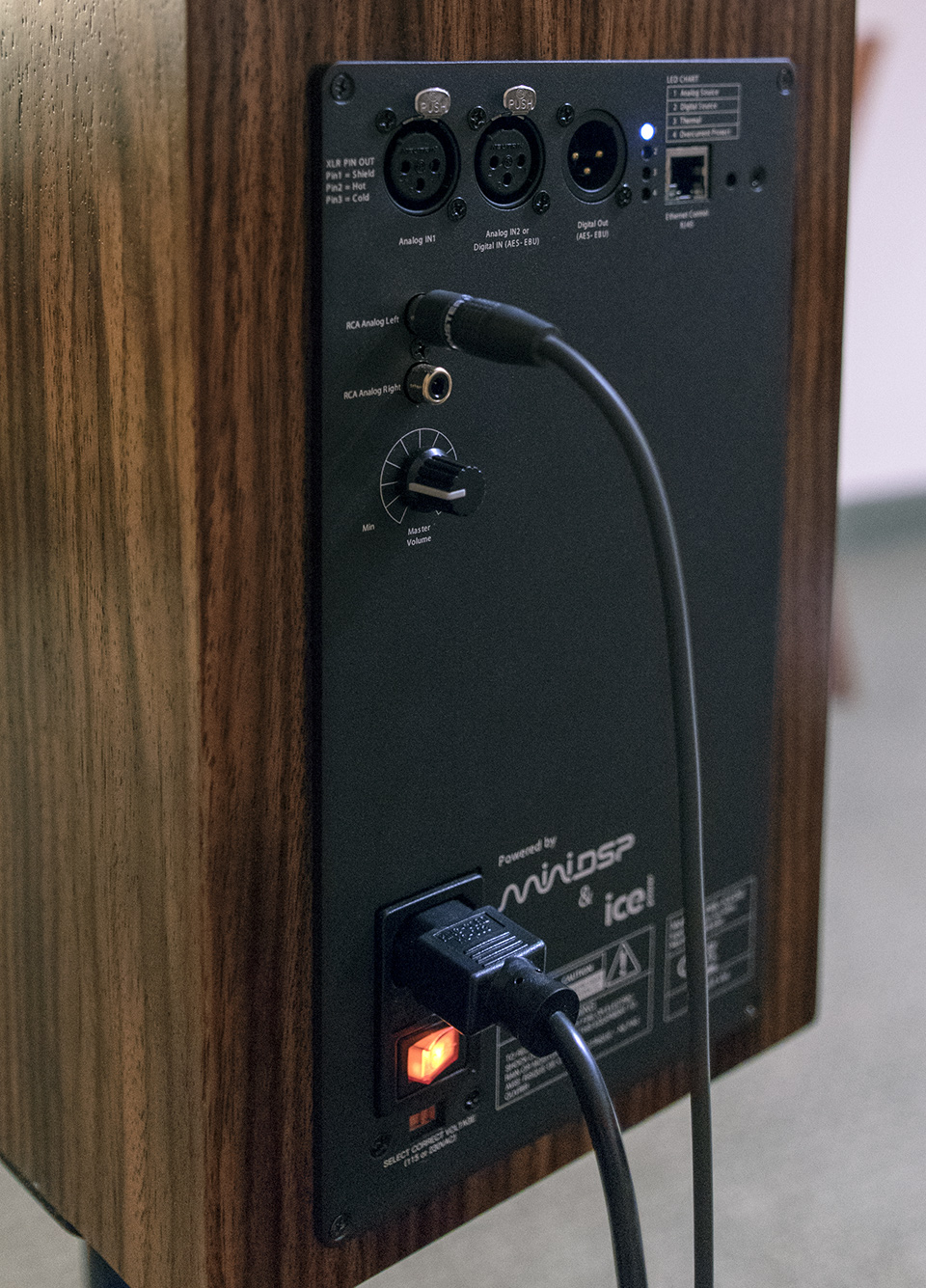
The cabinet design is sealed, with a MiniDSP plate amp mounted to the back handling bass extension flat to 32Hz. The crossover is a hybrid arrangement, with the woofer to mid crossover being done by the DSP, and the mid to tweet taken care of with passive components. While I'm sure the MiniDSP plate amp is pretty clean, the addition of some resistors on the tweeter certainly helps to remove the hiss found on most active systems.
Rosso Fiorentino Certaldo
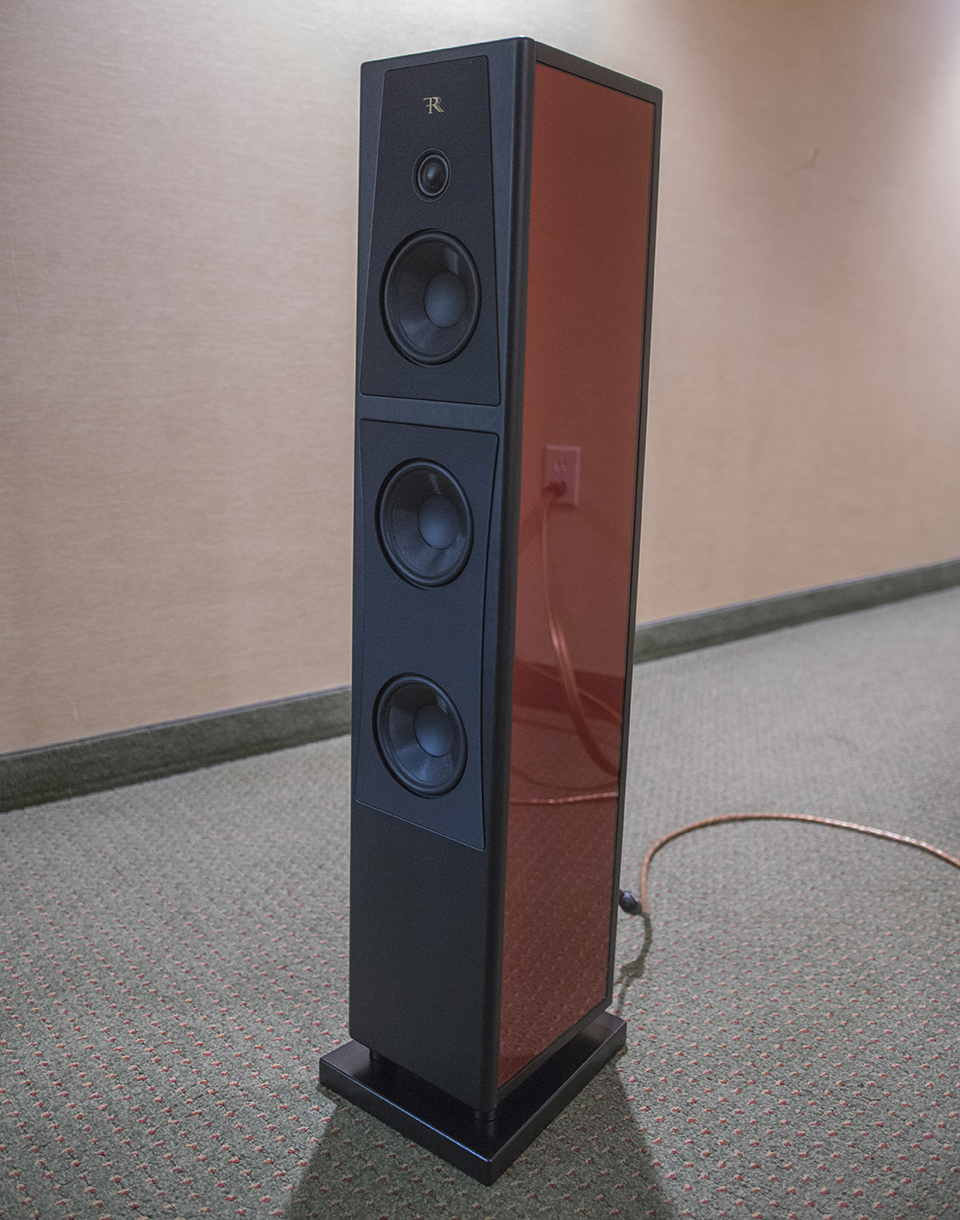
This is another of Skip's rooms, and these speakers are here to play second fiddle to the Siena mentioned above, if you like the Siena but can't afford them - this is the step down model.
The family voicing from the brand is obvious, with only this pair of speakers having a slightly less bloated lower midrange.
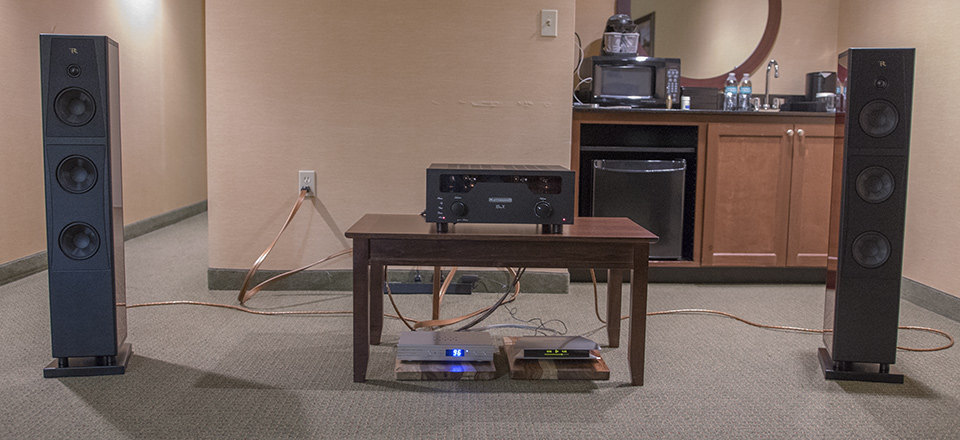
Distortion performance seems good, as expected from the price of the speakers. These did have a slightly wider dispersion, thanks to the more narrow baffle and smaller drivers.
Sonner Legato Semis
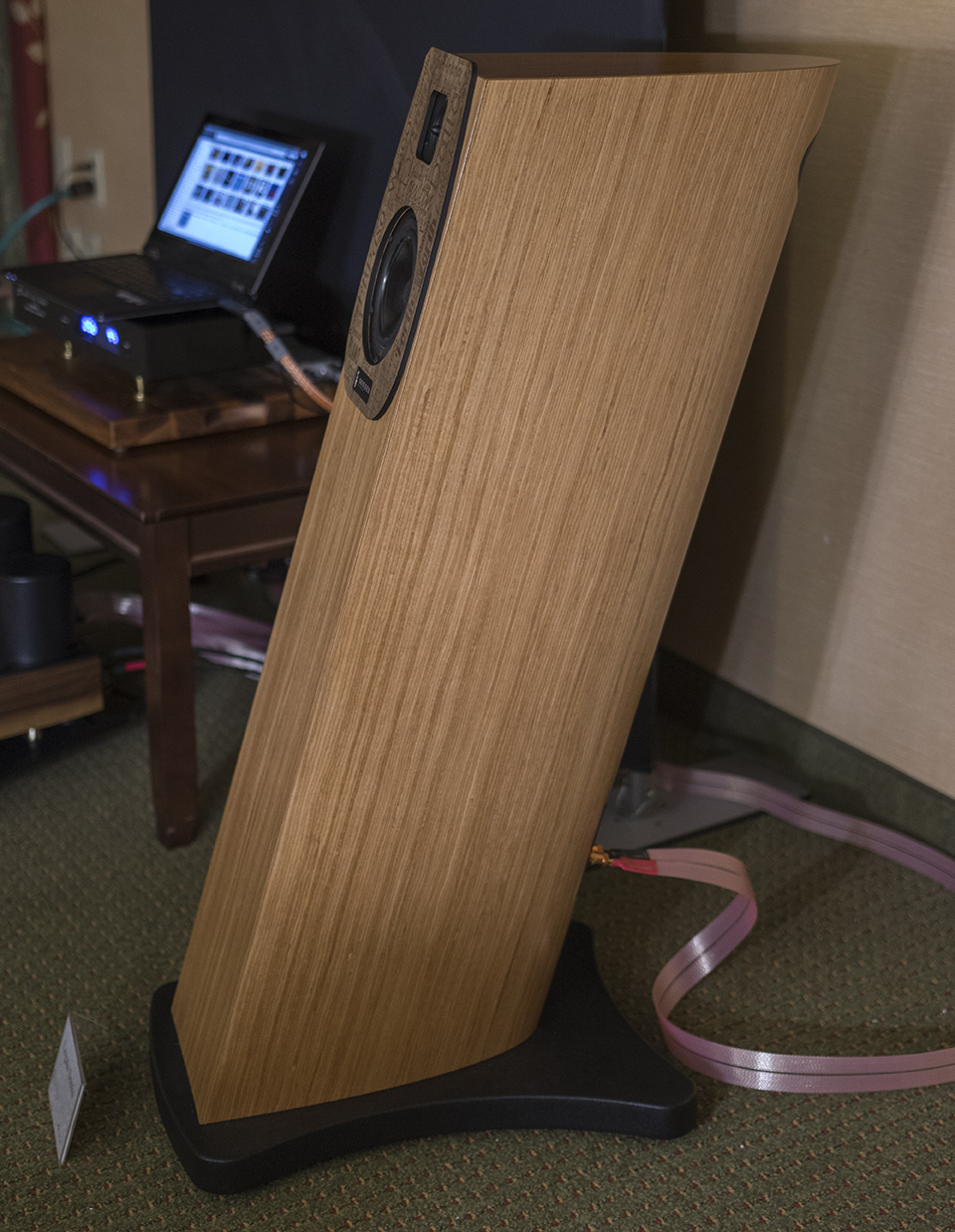
Similar to PureAudx, Sonner is another young company trying to find it's footing in the industry. Again we see a proven performer, the Peerless/ScanSpeak ring radiator with some innovative baffle mounted diffraction tricks.
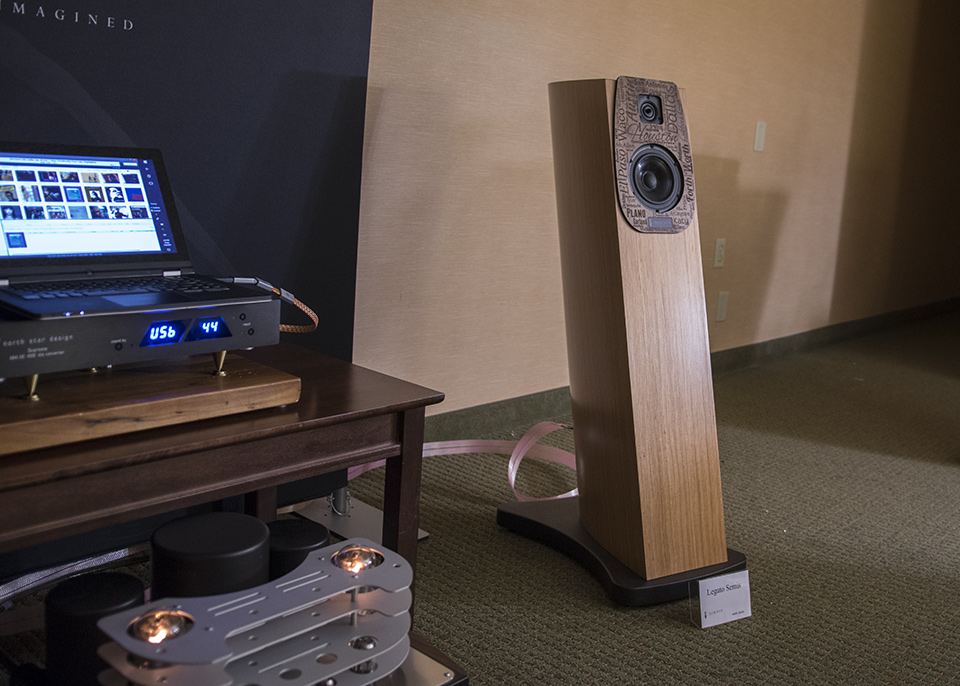
The thin piece of decorative wood held on by magnets to the baffle is there to take care of corner diffraction, and to augment the waveguide of the tweeter.
My guess is that this geometry would create a space for the wavelengths normally effected by the baffle width to cancel each other, similar to how open baffle speakers create nulls - or maybe it's just there to steer the effected sound to behind the speaker.
The leaned back posture of this speaker is to correct for time alignment, and lobe steering from the crossover is designed to point the sound front toward the listener's height.
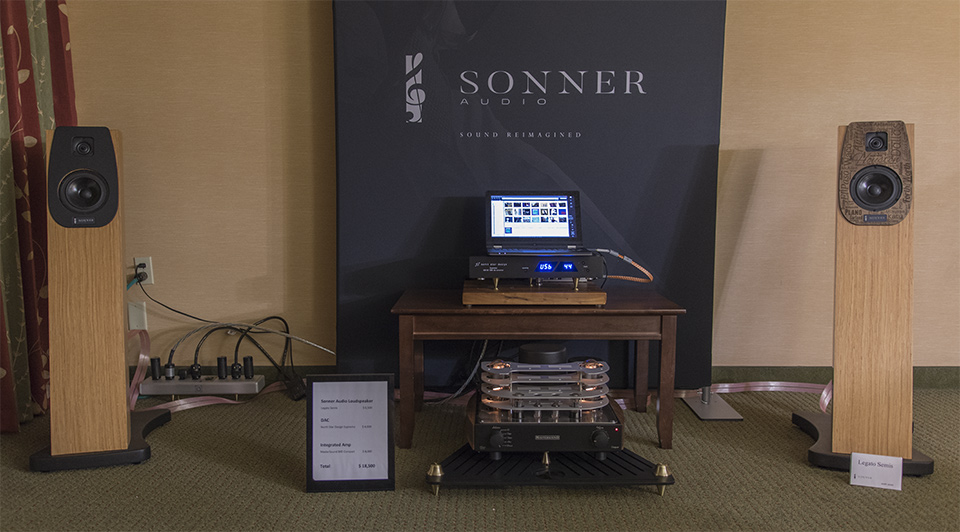
Over all sound was pretty good.
This being the final of Skip's rooms at the show there was a hint of warmed up lower midrange, but it was way closer to neutral than anything else Skip had at the show.
While Skip was the reason for Sonner being here at the show, this room was manned by manufacturer reps, including Gunny, president of Sonner.
After show hours I spoke with Gunny at length as to the state of the industry. He, like many in the industry is struggling to get his products to a larger audience, customers with less money and less square footage for stereo gear.
I hit him with the desktop audio sales pitch, and the trend of headphone users eventually migrating to smaller nearfield monitors. Maybe we will see something from Sonner in the future that checks these boxes.
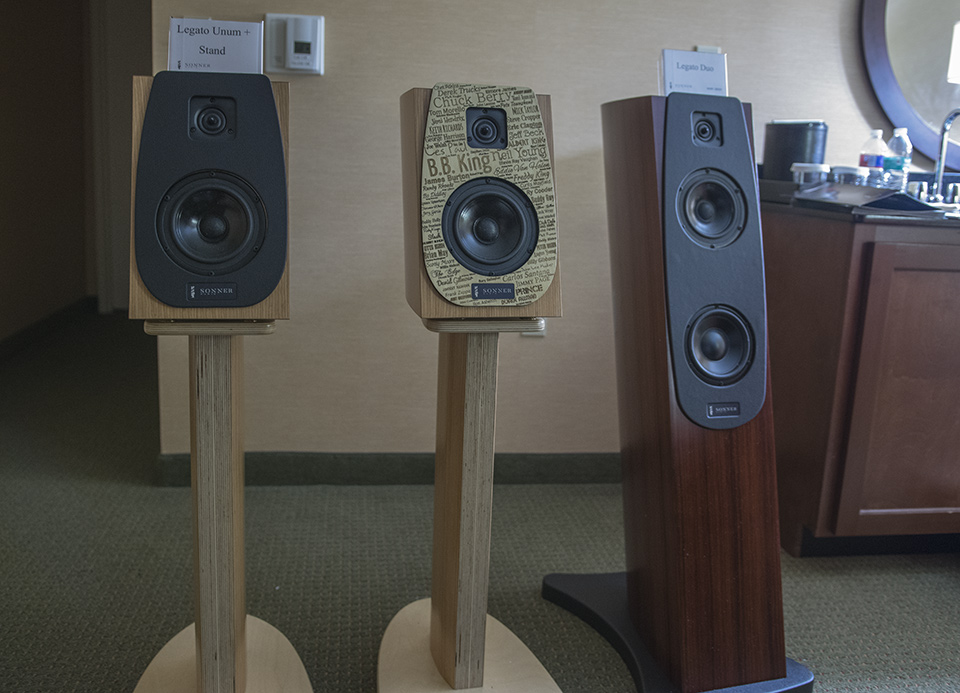
There were a few smaller stand mount options from Sonner, which cost less, but don't play quite as deep.
I promised one of the audio show junkies, a group who spend their free time following shows, that I would include his endorsement of the Sonner products. He pronounced his love for Gunny, for creating the best sounding speakers he's heard.
This is a might seem like a little thing, but for a small company this kind of talk is how you pick up new dealers, and make sales.
Stereo Clarity Icon 4
Steve from Stereo Clarity is the person most "in charge" of this event. He can be spotted occasionally applying diplomatic skills to smooth over any hotel representatives, or applying the minimum force to wrangle the public spectacle that is Lone Star. Stereo Clarity is one of a few part-time companies at this show. DIY guys whose insanity has progressed to the level of garage scale manufacturing, and selling one prototype at a time.
This is Stereo Clarities 8th year at the fest, bringing a different speaker most years, sometimes bookshelf speakers, sometimes line arrays. This year they have a pair of average looking tower speakers.
The some of the drivers here may look familiar to readers. The Icon 4 uses the same Wavecor tweeter and woofer as the CSS Criton 1TD v2.
Fixing the weak spots of that speaker with a dome midrange driver from Dayton, and another woofer to augment the bass response.
While the textured truck bedliner paint on the sides and rear of the cabinet may look a little rough, the front of the speaker looks remarkably well layed out and finished for a one off speaker.
Besides being one of the more reasonable form factors at the show, these speakers sounded perfect tonally. No goofy bullshit, no overdone bass, no problems with the midrange - just good no-frills performance.
The Port tuning seemed low enough to fill in the bass, but I heard
from other attendees at the show that the speakers have audible chuffing while playing a pipe organ piece. This is yet again another example of why having the port on the front of the speaker is never a good idea.
While the speakers were some of the best all-round performers of the show, the star of this room is the OneSouce Media Server.
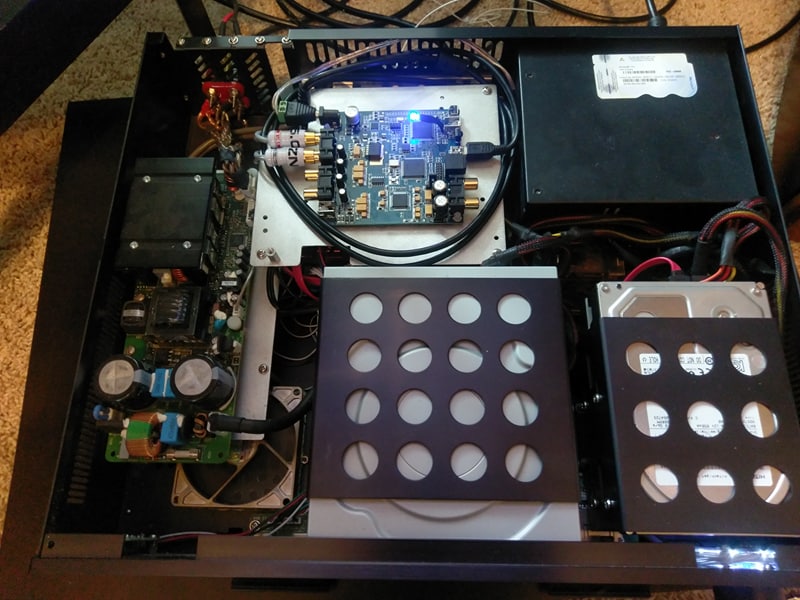
This one box includes up to 16TB of storage, a bluray player, Windows media server with Netflix and Hulu that can be operated by remote, a MiniDSP - for subwoofer integration, and even a 2 channel ICEpower amp module putting out 250wpc.
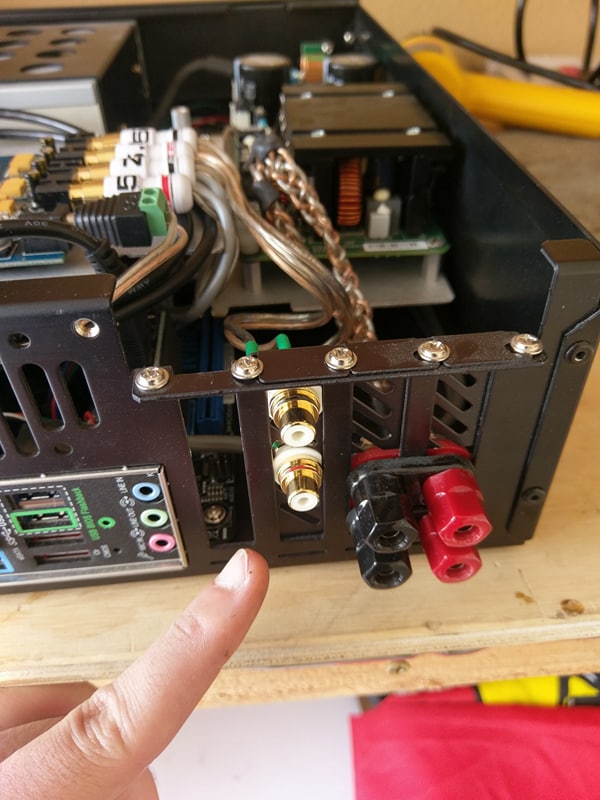
The whole thing sat quietly with no noticeable fan noise, and performed flawlessly at absurd volume levels. This whole setup with speakers is a perfect setup if you want a fast track to start and finish the hobby.
Magico A3
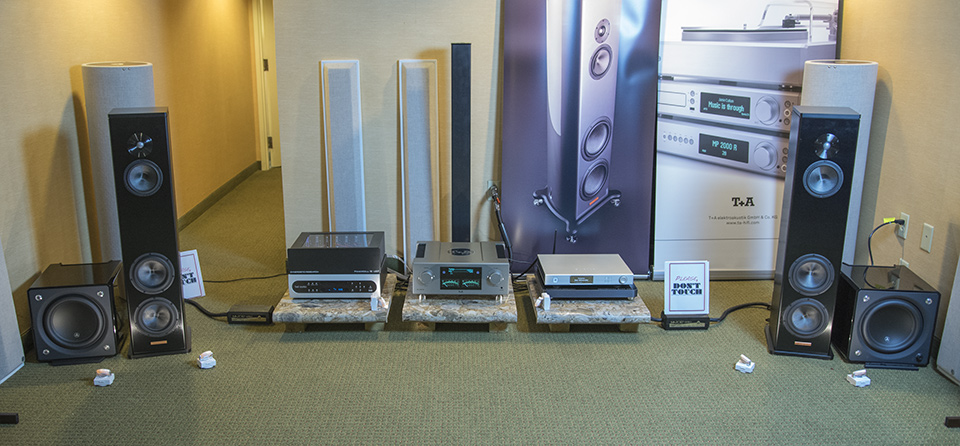
Magico Towers for less than 10k is the headline, and all the status seeking boomers can raid their 401k to grab them up as quick as Magico can make them. Based on the performance I heard at the show, they are more flawed than most speakers available for $2k.
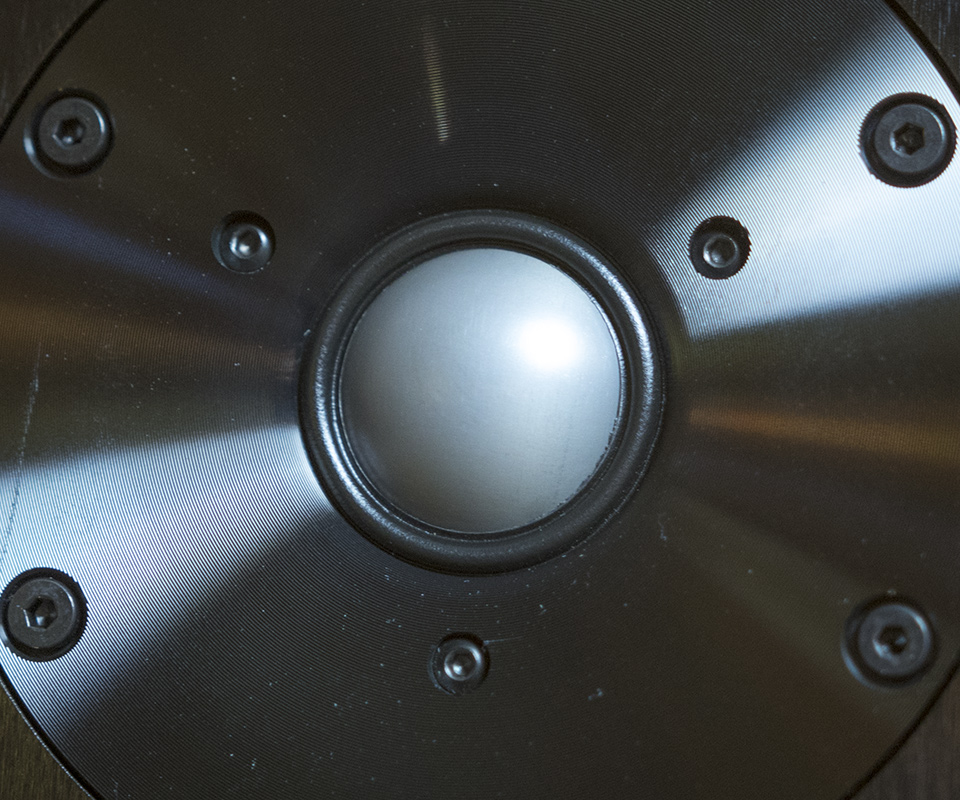
Outside of the aluminum cabinet, this tweeter is the only thing I liked on this speaker. This is beryllium driver that does it right - no wave guide, just a bare dome, and reasonable surround. I even like the extra height of the speaker above the tweeter, while aesthetically it's messy, it is acoustically smart. This is the nicest dome tweeter implementation I've heard.
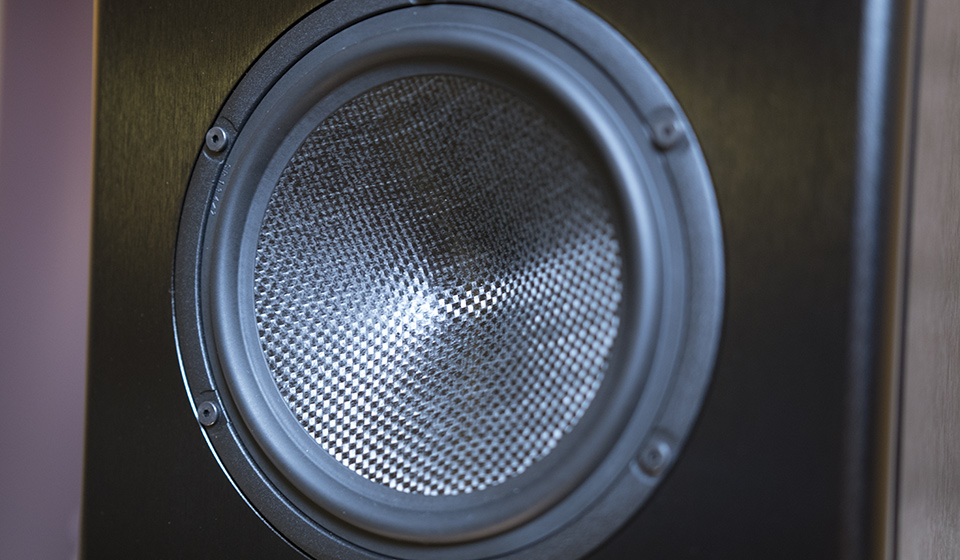
This midrange is the problem child of this speakers.
The sales rep was spouting all forms of bullshit about graphene being a superconductor at room temperature, and that the layer of graphine - in the cone - was going to provide a performance advantage.
I'm a pretty creative guy, but I can't think of a single benefit of putting a molecule thick layer of graphite onto a speaker driver - I'm pretty sure the epoxy used to secure it had more effect on the performance.
So outside of snake oil, what is my beef with this driver? Well, I'm pretty sure the shape of this midrange is the reason why the whole speaker is a sonic failure.
There is a hollow missing section to the lower treble. I'm pretty sure it would show up in an on and off axis response, so Magico either likes this, or has no idea what they are doing.
My suggestion to any A3 owners out there is to buy a dust cap and glue it to the front of the driver, this should improve things right away.
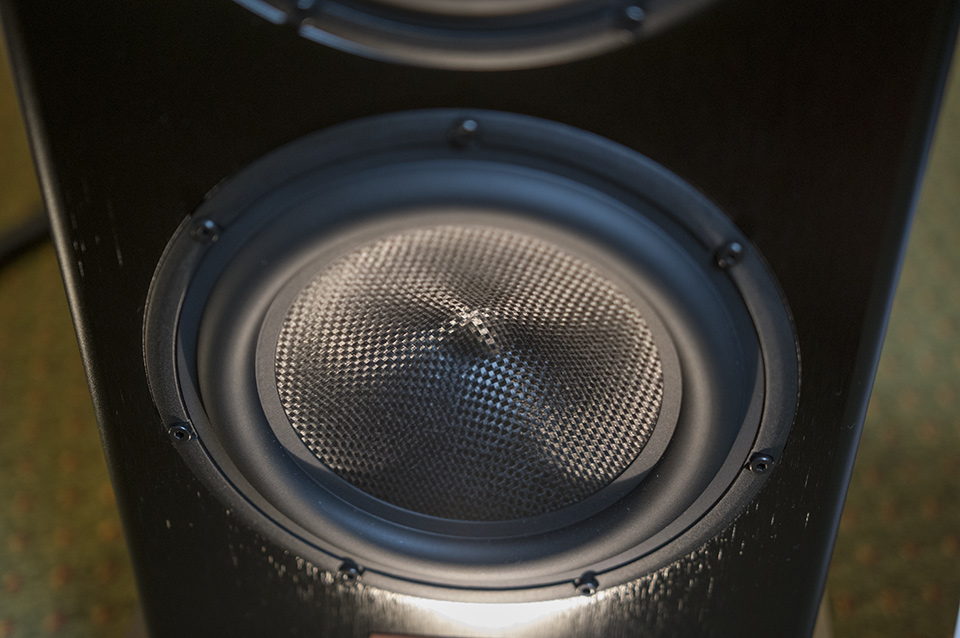
The woofers have the same stupid shape as the mid, but it does no harm to the lower frequencies.
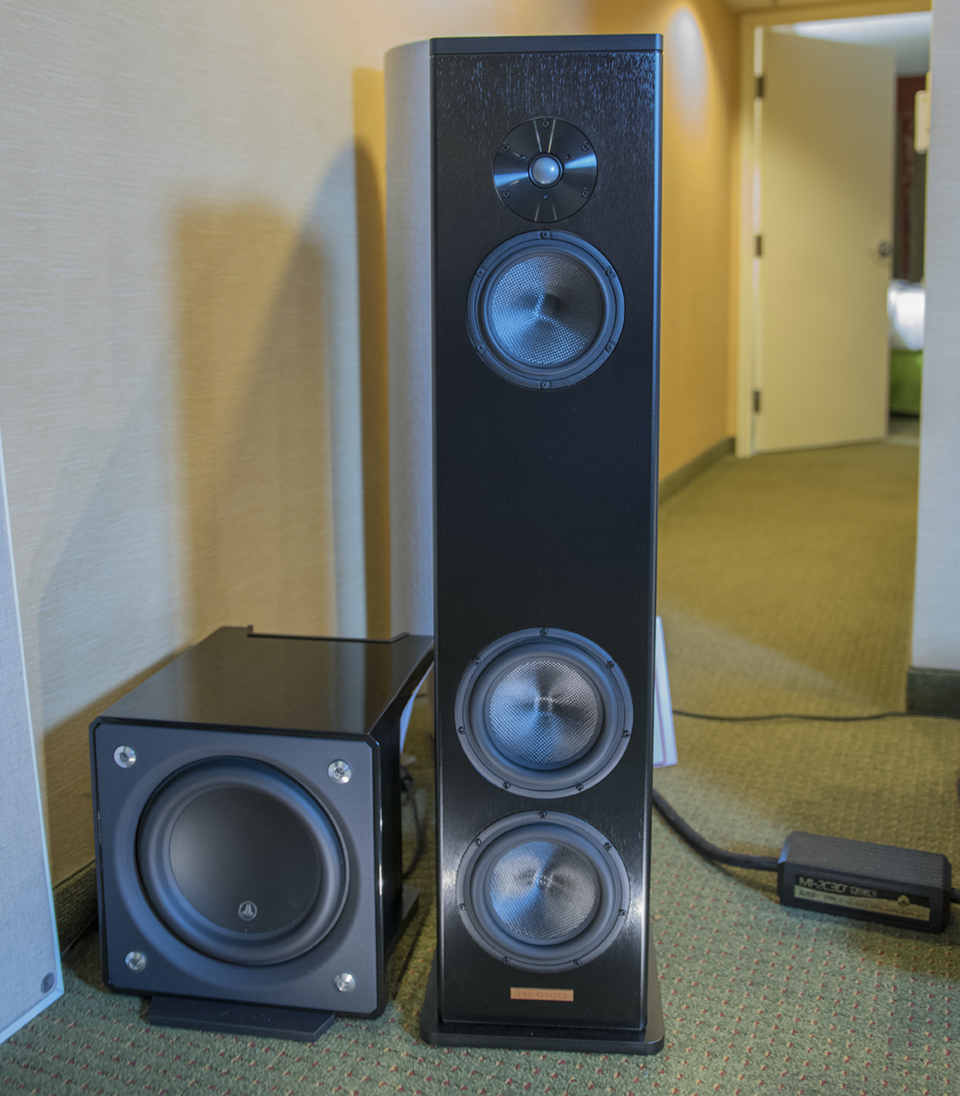
Not content with selling cheap Magicos, the sales rep was pushing hard for the pair of JL Audio Phathom Subwoofers, which I'm sure have incredible margins, as a requirement to the towers. Doing A/B tests with and without the subwoofer on, one audience member said that it sounded the same, the JL's just made more stuff rattle - I told you Lone Star has good listeners.
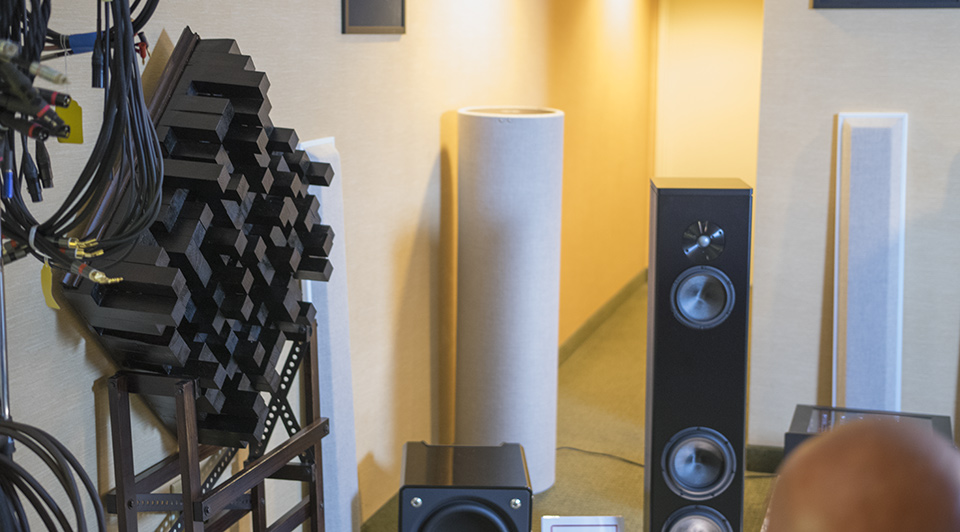
I complained about this room treatment which was distracting while trying to nail down the speaker, but after about 30 minutes of accommodation I was able to identify the speakers problems in spite of this camouflage.
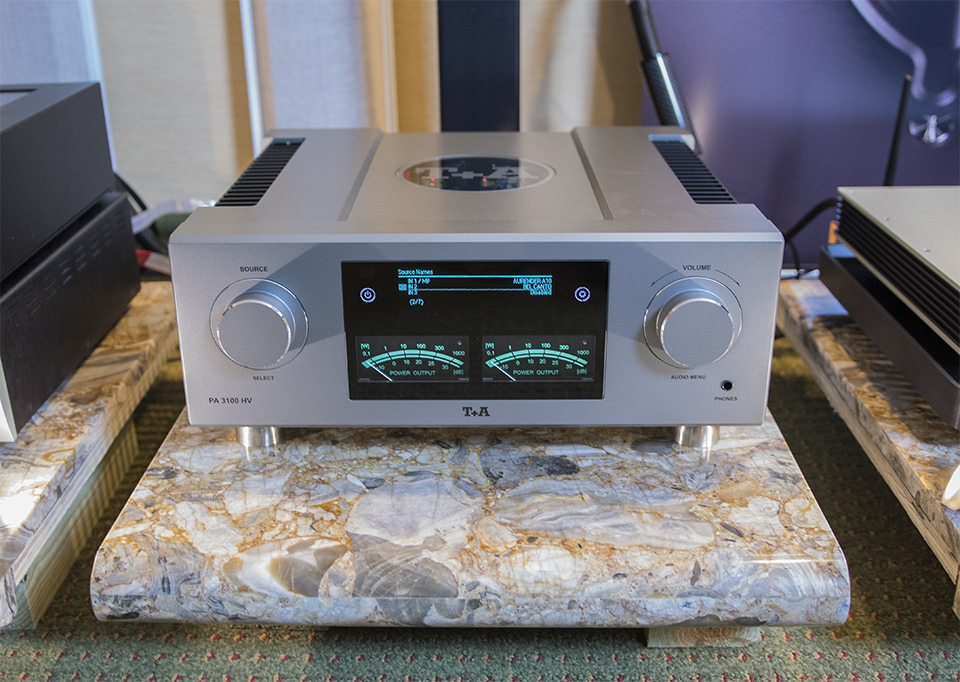
While I didn't like much in this room, everyone I talked to agreed that this was the sexiest piece of gear at the show - and I think it was the only solid state class A/B amp in any manufacturers room.
Usher Audio Mini-X Diamond
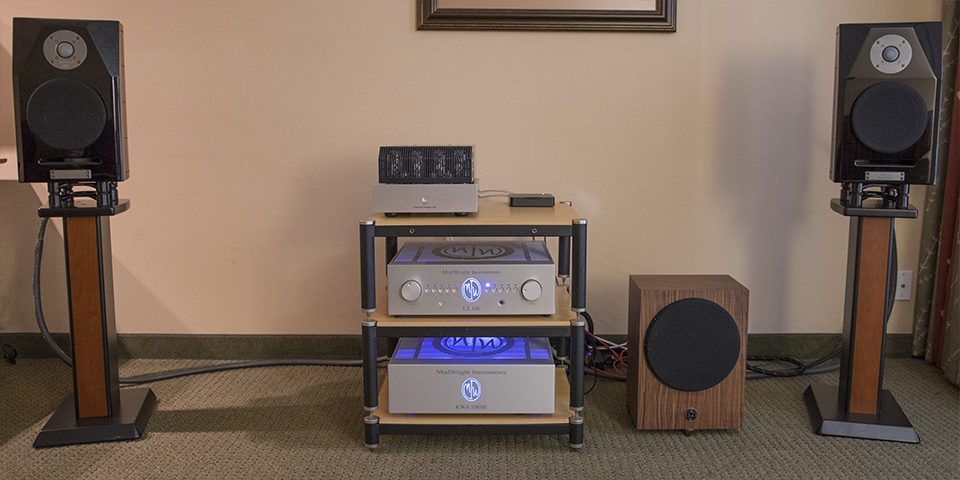
By far one of the coolest parts of Lone Star is that some people bring their personal systems to the show. As there are no fees charged for exhibiting, anyone can grab a room on the 2nd or 3rd floor and play tunes for the people who stop by.
I don't recall the electronics used in this rig, but the ModWright name is one I'm familiar with from back when they were tweaking output stages on CD Players. Good to see that they, like Burson Audio, were able to transition from mods to manufacturer.
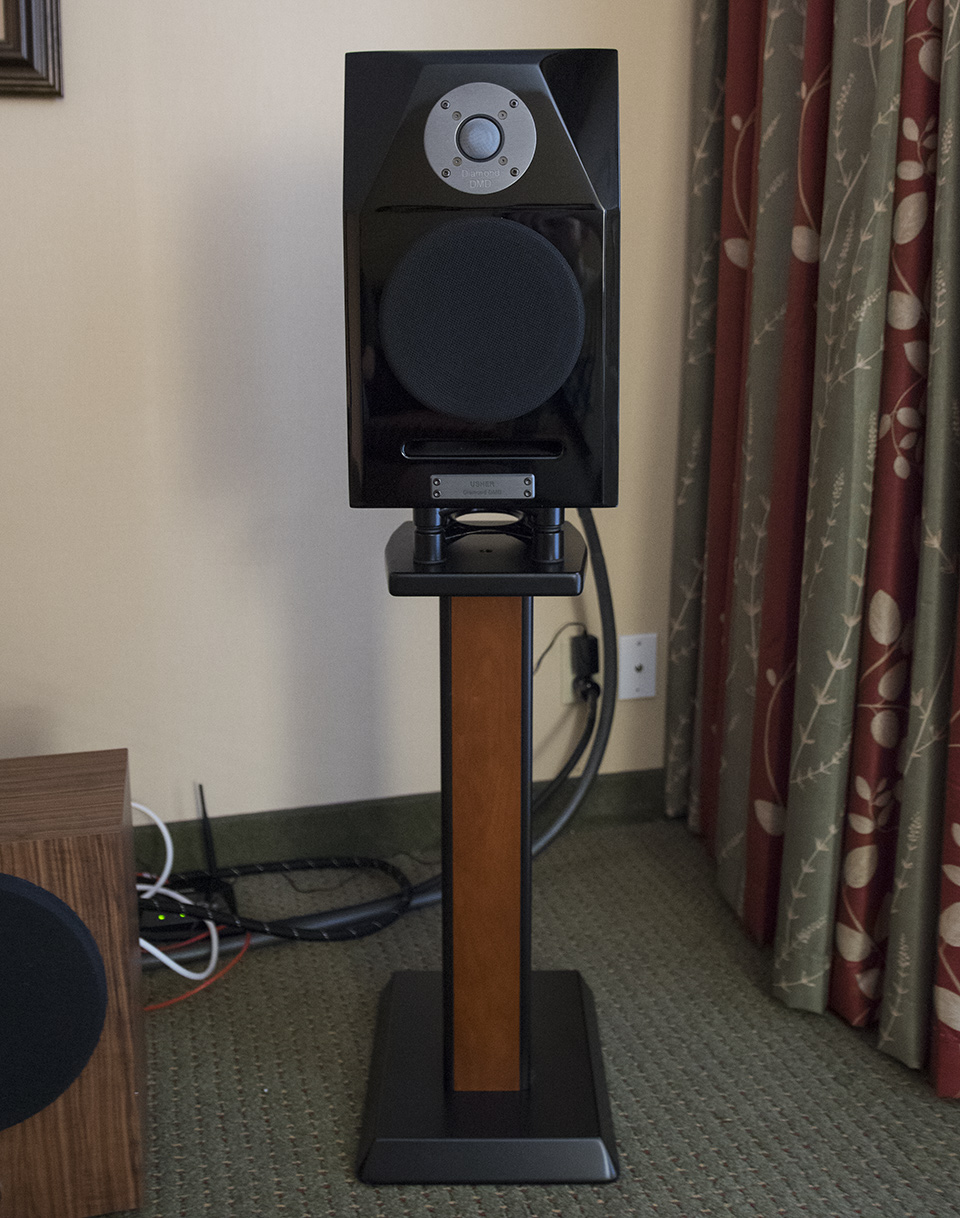
The system in this room was a well rounded, and pretty portable rig. The small Usher speakers and tiny Subwoofer did a pretty good job of playing tunes. I thought the top end was a little over done, but the midrange and extension were admirable from such a simple setup.
Austin Audioworks
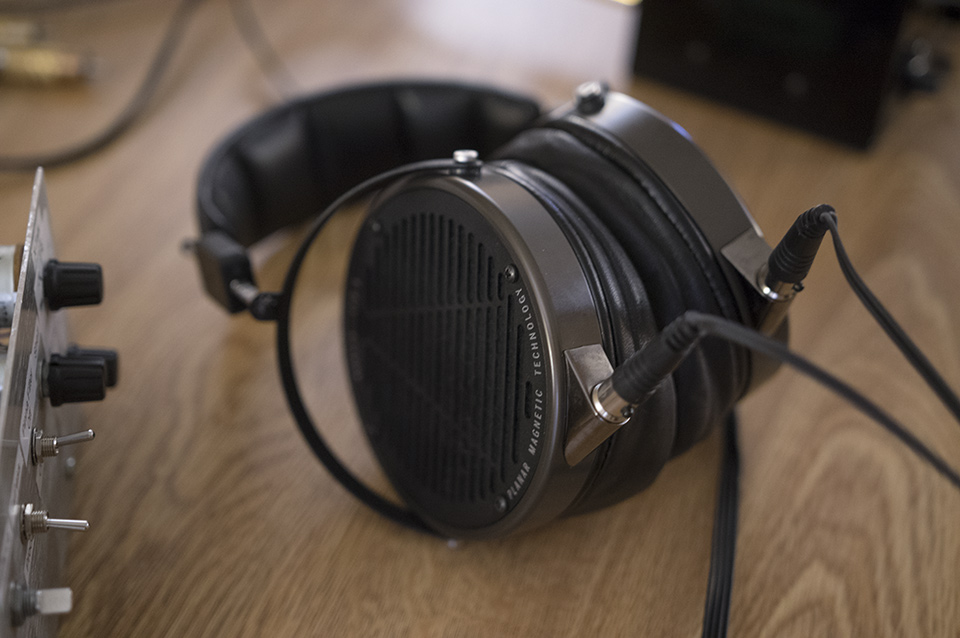
The only guy with no worries about room modes was Austin Audio works. This old timer had a room setup with a few headphone amps and dacs, as well as boxes that played with phase and response to get a more involving sound from headphones.
I don't recall the guys name, but he had worked as an freelance engineer for some of the big names in audio back in the 70's and 80's.
I talked in this room for a while, picking his brain, talking tech about HRTF measurements, and hearing stories about some of the hurdles that existed in the development of many technologies we take for granted.
Headphones are not my thing, but I had a trial run in the past with the LCD2 headphones Austin Audioworks was using. To me they sounded like headphones, but the bass was linear, so there is that.
Brown Audio Labs
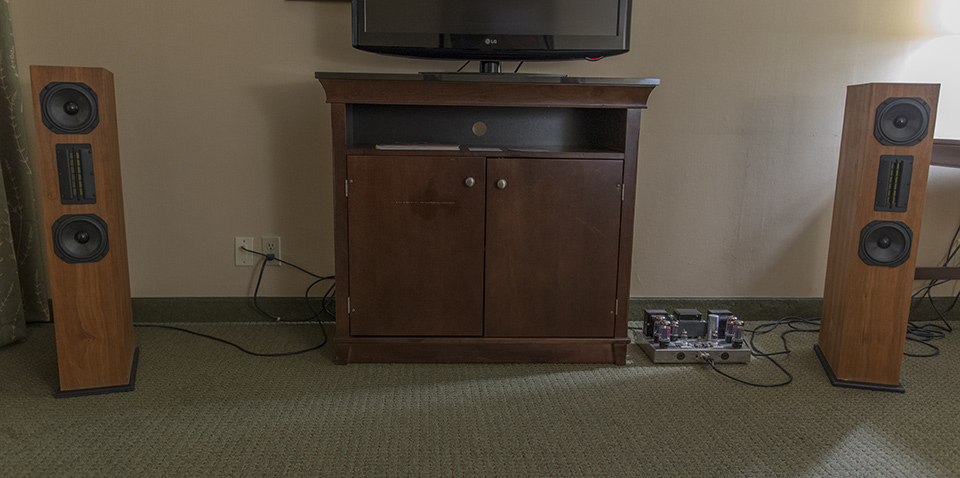
Denny from Brown Audio Labs seems like the kind of guy to not have a spec of dust in his house, and his hand built gear looked better than much of the high end gear I've seen. The Brown Audio Labs room was yet again another garage scale manufacturer that showed up the big boys when it came to sound.
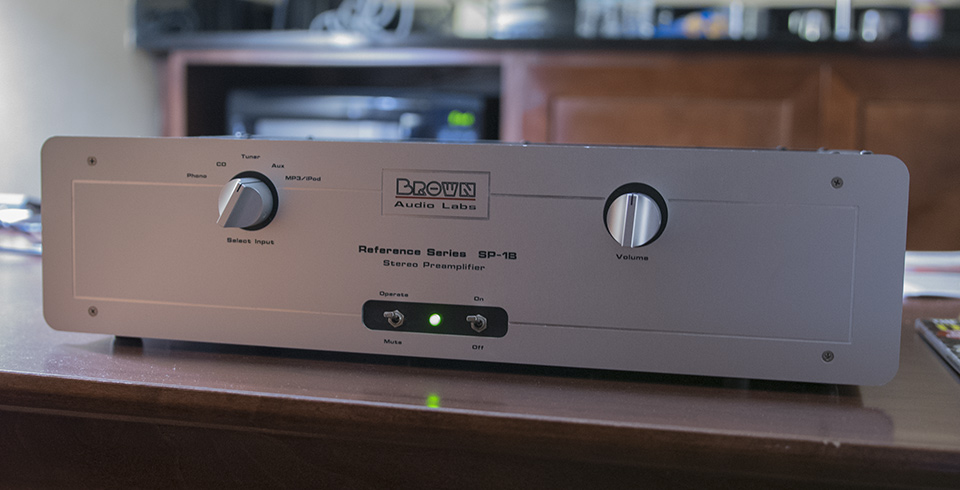
The pride of the room was this valve based preamp. While I'm not too knowledgeable in the qualities of frontend gear, I do like the switch that toggles between "mute" and "operate" - it's the quaint details that make all the difference.

These speakers are a Brown design as well, using a very wide MTW setup, with the bottom woofer offering support for lower frequencies. The big planar tweeter, based off of a design from Bob Carver, sounded smooth and natural without being as noticeably beamy or narrow vertically as the true ribbons from RAAL or Fountek. Woofers sounded smooth and the crossover was well implemented as I detected no cone break up while listening.
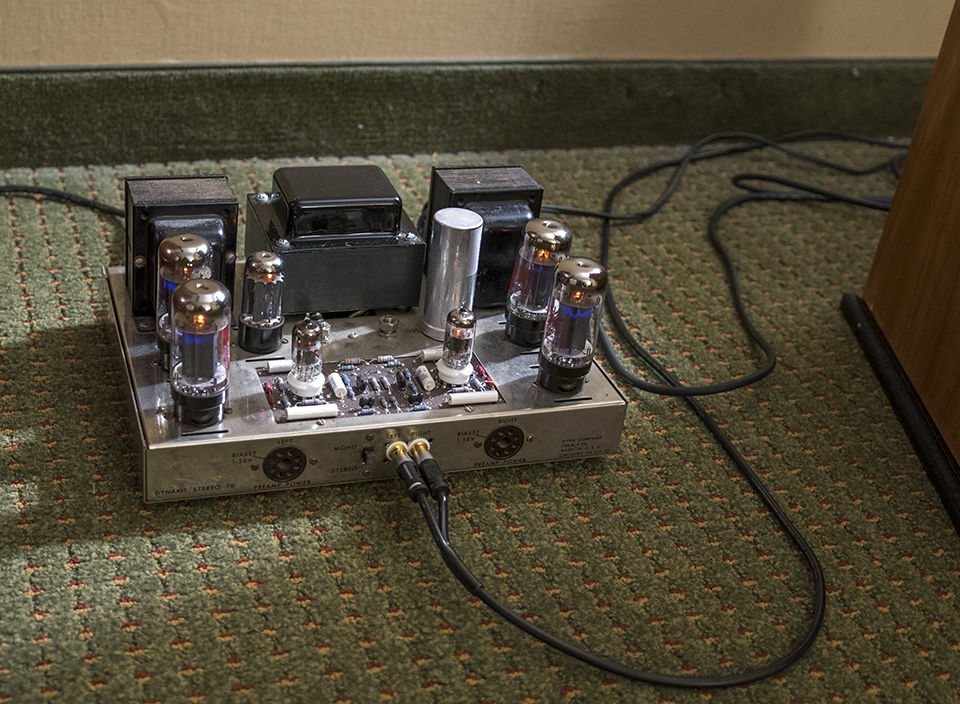
Denny was running a familiar amp to many, an old Dynaco ST70. From what I gather he is working on a single ended monoblock tube amp design of his own, and hopefully we will see that at the next show.
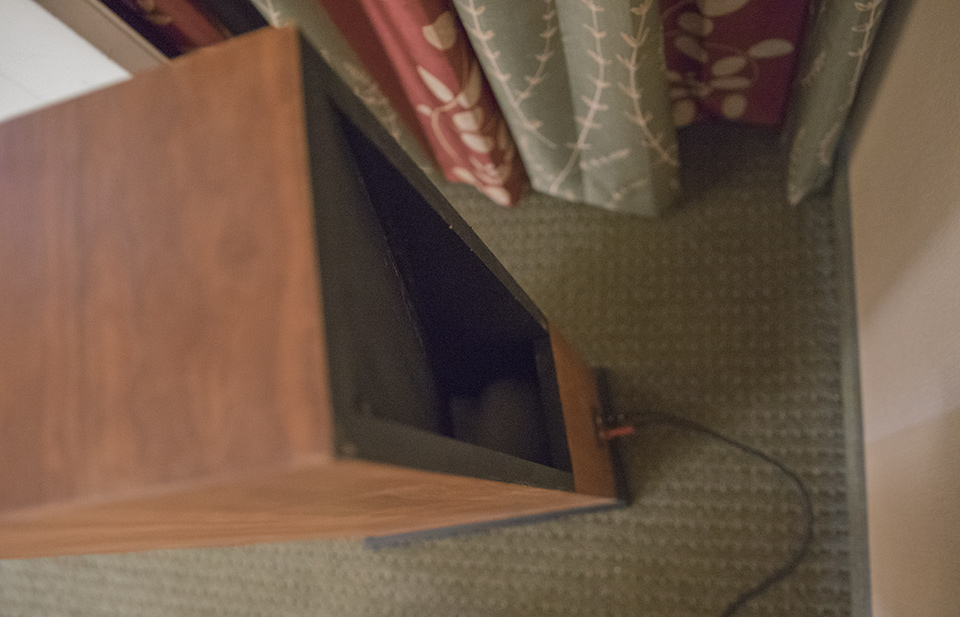
The speakers are using a mass loaded transmission line, which extends the bass lower than you would expect. After a request for some bass heavy music, I got to hear some pipe organs billowing out of the speakers, and it sounded even and full. I figure the speaker are probably flat to 35Hz, maybe more in room.
Blow Torch Audio
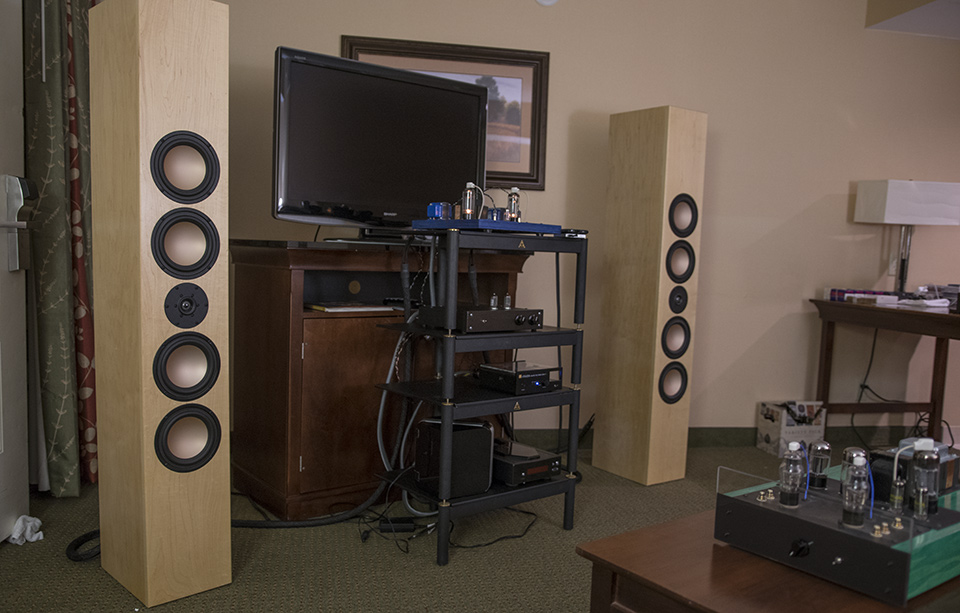
Blow Torch Audio goes for the steam punk mad scientist aesthetic. The room was crowded with tube amps, many looking kit built, some looking like vintage finds from juke boxes or old consoles. The speakers here are using lots of HiVi aluminum drivers and some type of tweeter that I don't recognize off hand.
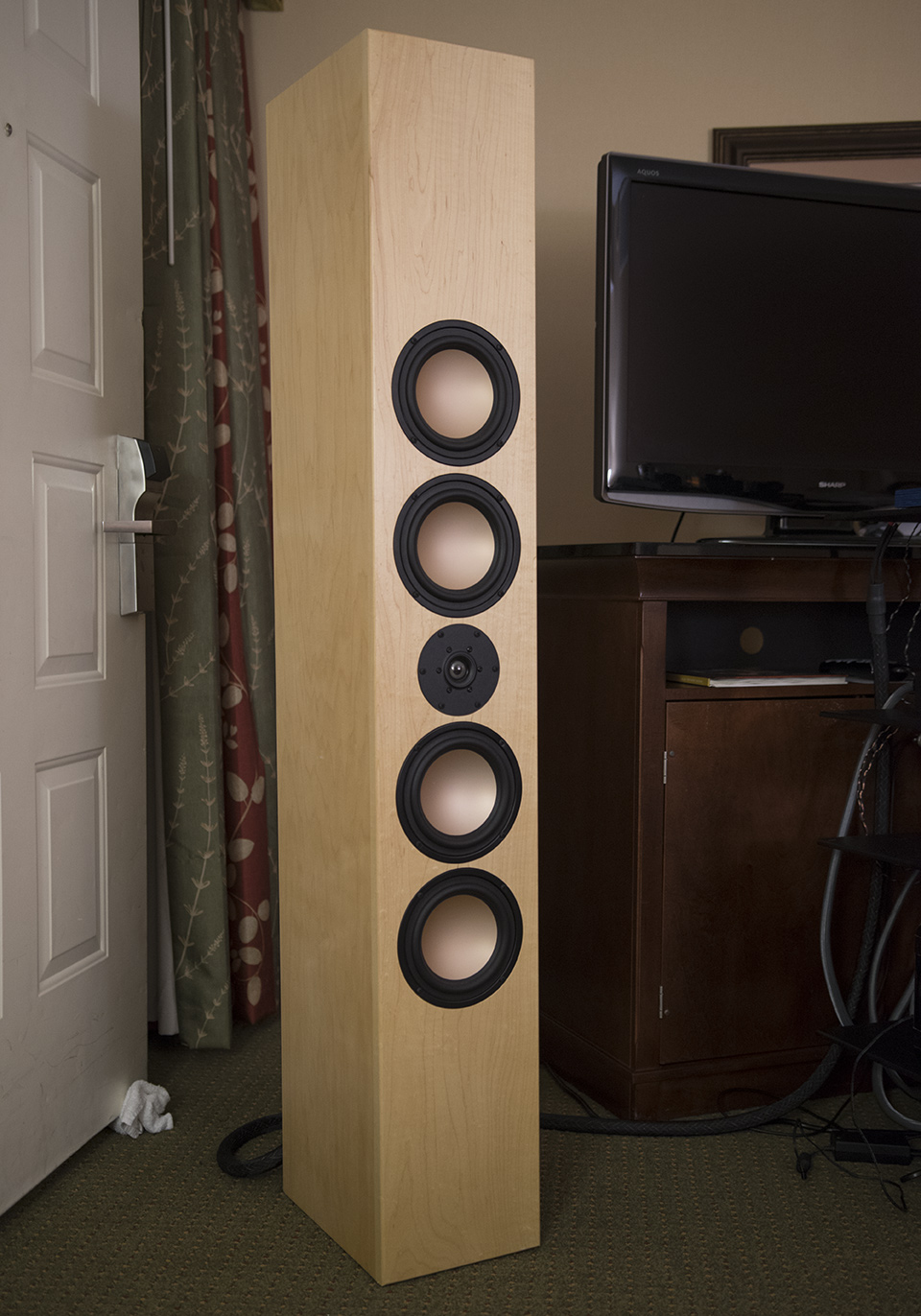
The sound from these speakers was bad. It took all I could muster to stay in the room long enough to snap a few photos. My guess here is that the cone breakup of the aluminum woofers was not taken care of in the crossover, and what is created from the harmony of 8 screaming aluminum cones is a sound should not exist in this world.
Audio Crafters Guild NT10
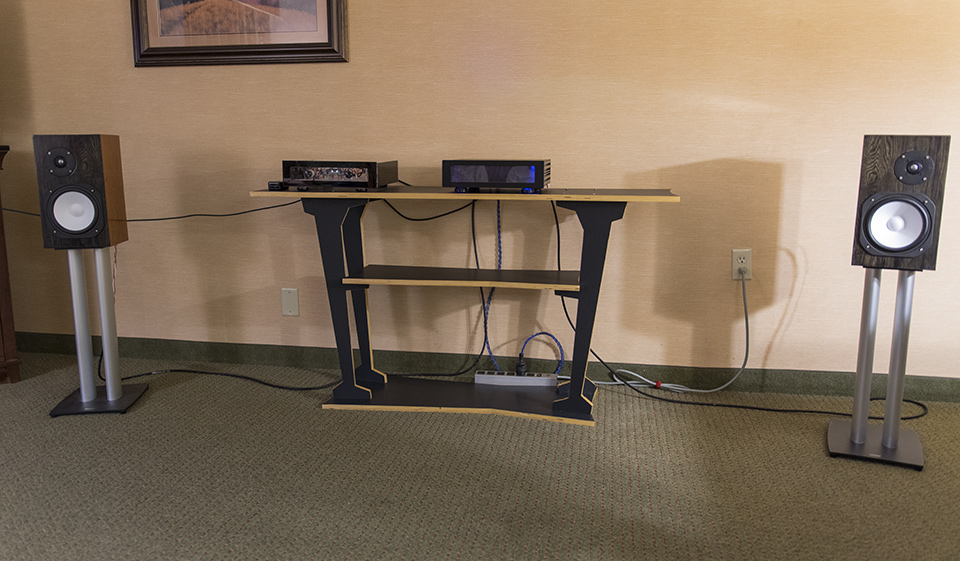
Audio Crafters Guild is a project of Norman Tracy, a contributor to Positive Feedback and big supporter of the show. There is no doubt that Norman is a better writer than me, you can read his show report here. Sadly, I have only negative feedback for his speaker.

The design is inspired by the Yamaha NS10, and has a sealed woofer and a dome tweeter, with a focus on phase performance and not much else. Studies performed by Toole and Olive, show that phase response is not a variable that correlates with speaker preference. This has been my experience as well, so the design goal of this speaker was lost on my ears.
I could not listen to this speaker for more than a few minutes without being uncomfortable. The speaker is so top end heavy that I could not determine if the squeaking and screeching I heard was from cone breakup, or just a byproduct of not producing anything under 150Hz. This system wins the category for most likely to need a subwoofer.
YG Acoustics Carmel 2
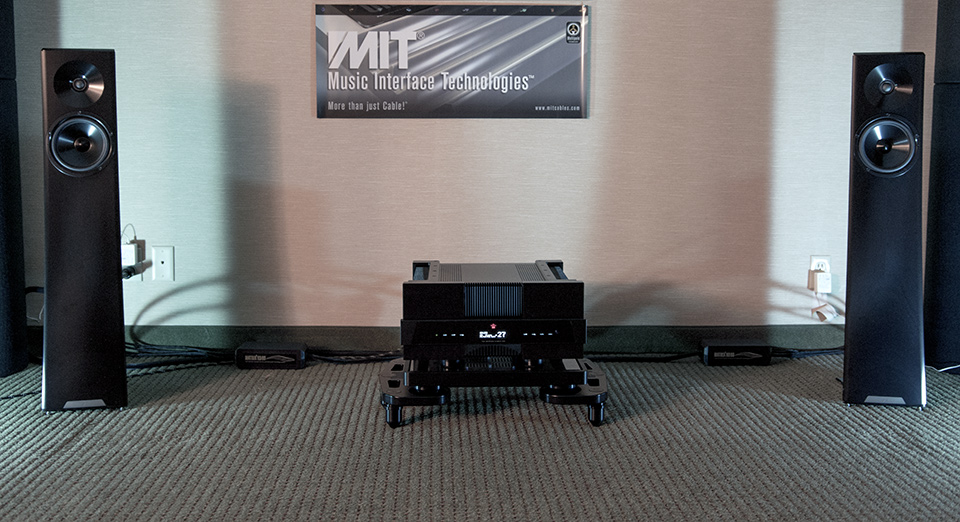
YG Acoustics is the other high dollar aluminum boxed speaker maker. While it might not have the brand recognition of Magico, in my personal opinion, YG does more right generally with aluminum than Magico. This Carmel 2 is the cheapest speaker YG makes, coming in at a cool $26k before any dealer discounts. It's an older design from 5 years back, and there are a couple of things I think should have been fixed in the last 5 years. The Bass response is perfect, zero complaints - best at the show above 50Hz. A non resonant solid performance - perfectly flat with zero extra information. I have only ever heard this level of bass performance coming from YG cabinets, which are made from extruded aluminum. The cabinet of the Carmel 2 is over 2 inches thick in spots. YG's Bass performance is the Moon landing of HiFi, it's a god damn glorious technical achievement.
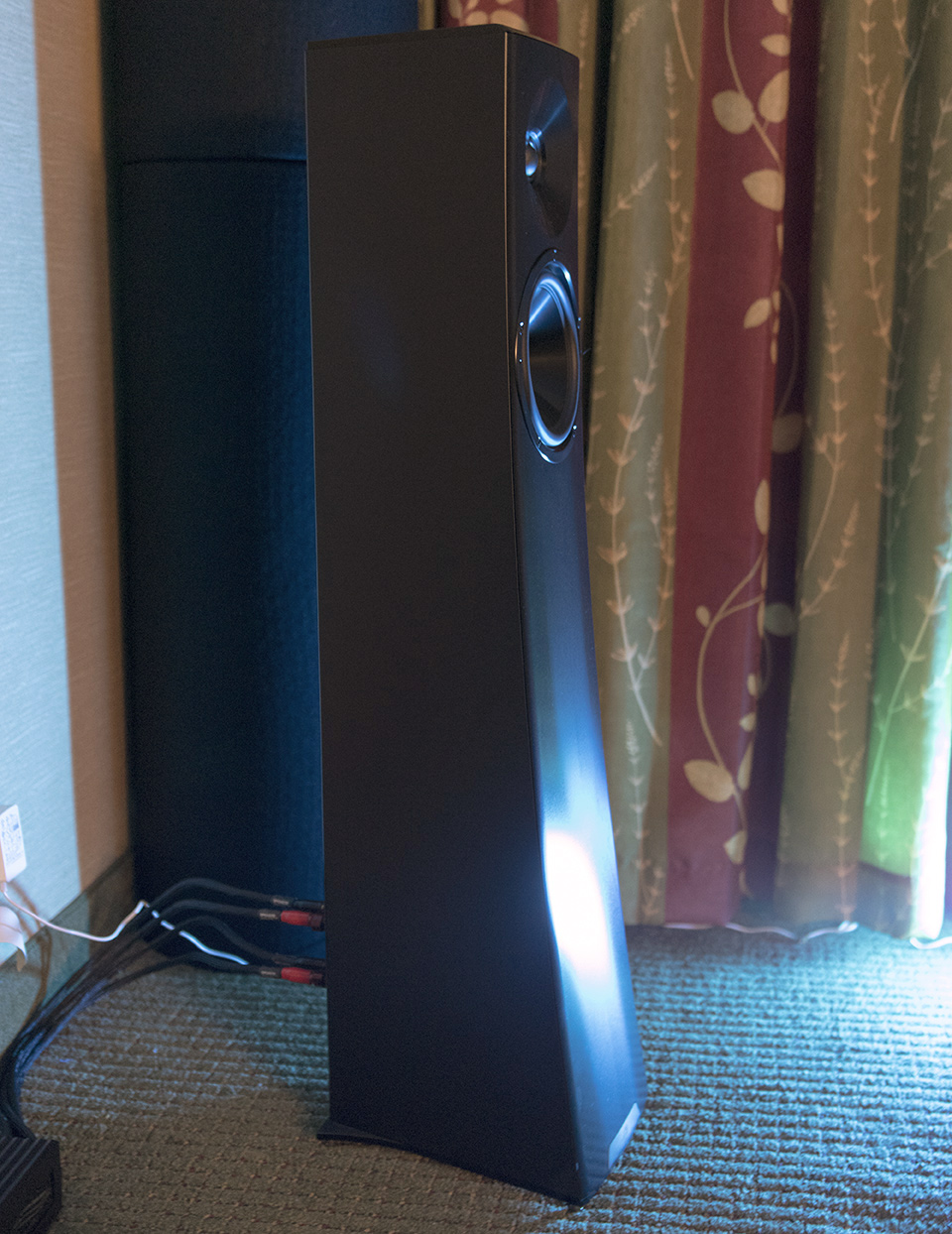
So what is my beef with these speakers - well, it's the tweeter, not the driver, but everything else: the horn loading, center to center spacing, lobing, and crossover. It's all shit. These speakers blast treble, from 3kHz-6kHz off axis way louder than on axis. This behavior of the speaker fucks the whole room - there is no hope to escape outside of bundles of room treatment, or waiting for your upper octave hearing to die off from old age. There is nothing more disappointing to me than an amazing speaker design that is deeply flawed in one area that should be so easy to get right.
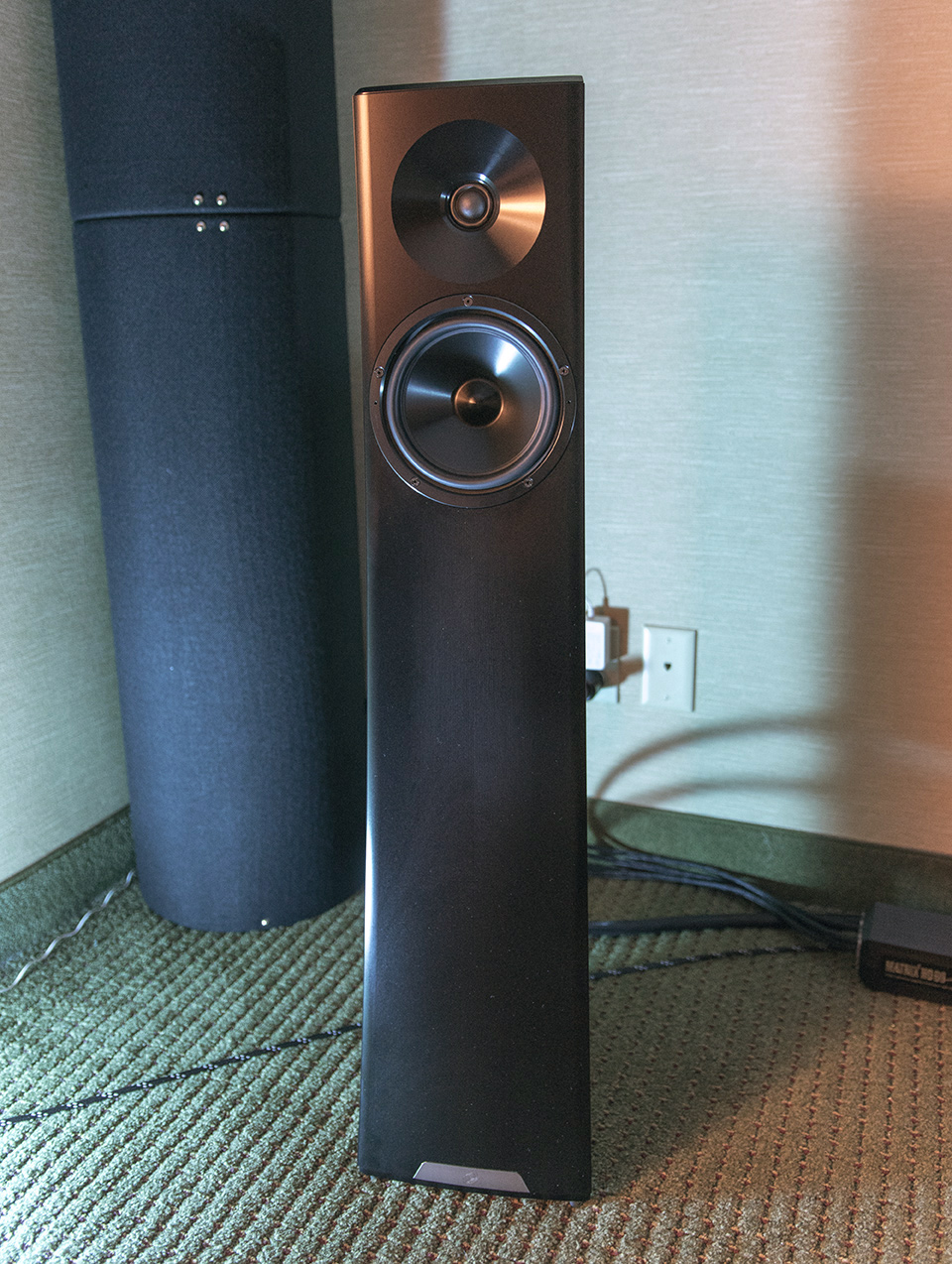
Scott and the gang from Supra HiFi, the YG dealer in the Dallas Area were not worried about the better sounding speakers from the DIY or personal systems, they were gunning for the "cheap" Magico speakers a few rooms down. While I disliked both systems, I told Scott that the Magico has a better tweeter, the YG had a better everything else.
VanZyl 1812 Backfire
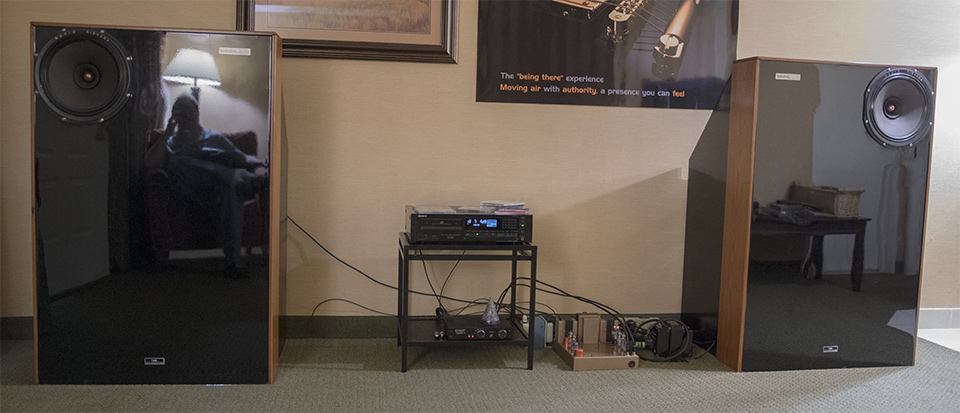
The 1812 Backfire are full range rear horn loaded speakers. I have never heard a properly designed rear hornloaded speaker, as I'm still looking for some Klipsch K-Horns to put my ears on. Bass in this room sounded fine, no complaints, but I didn't hear anything extraordinary either.
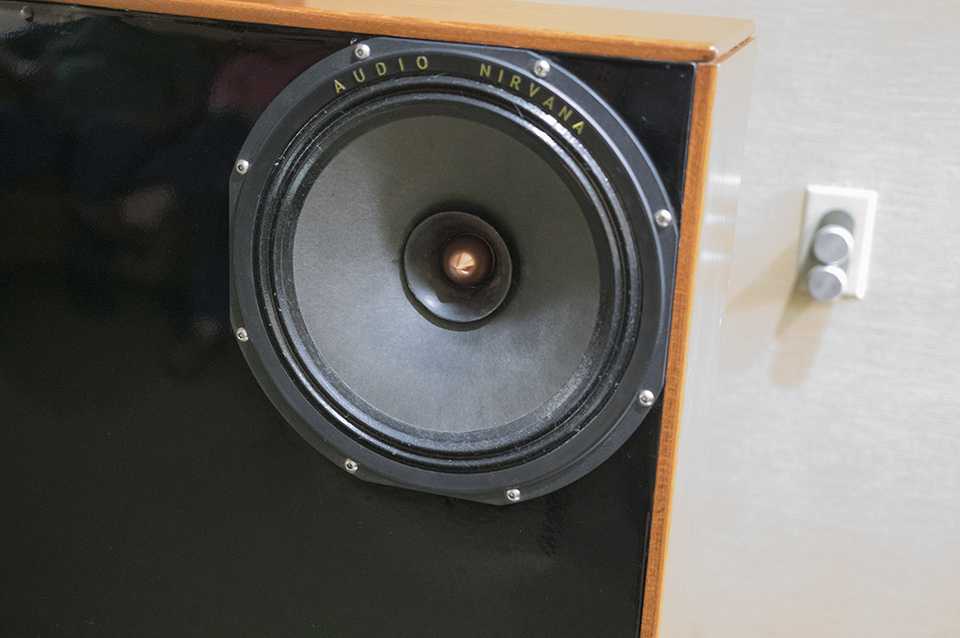
Audio Nirvana drivers are a product some full range enthusiasts name as the standard bearer for performance in the sector - more so than Mark Audio or other well known options.
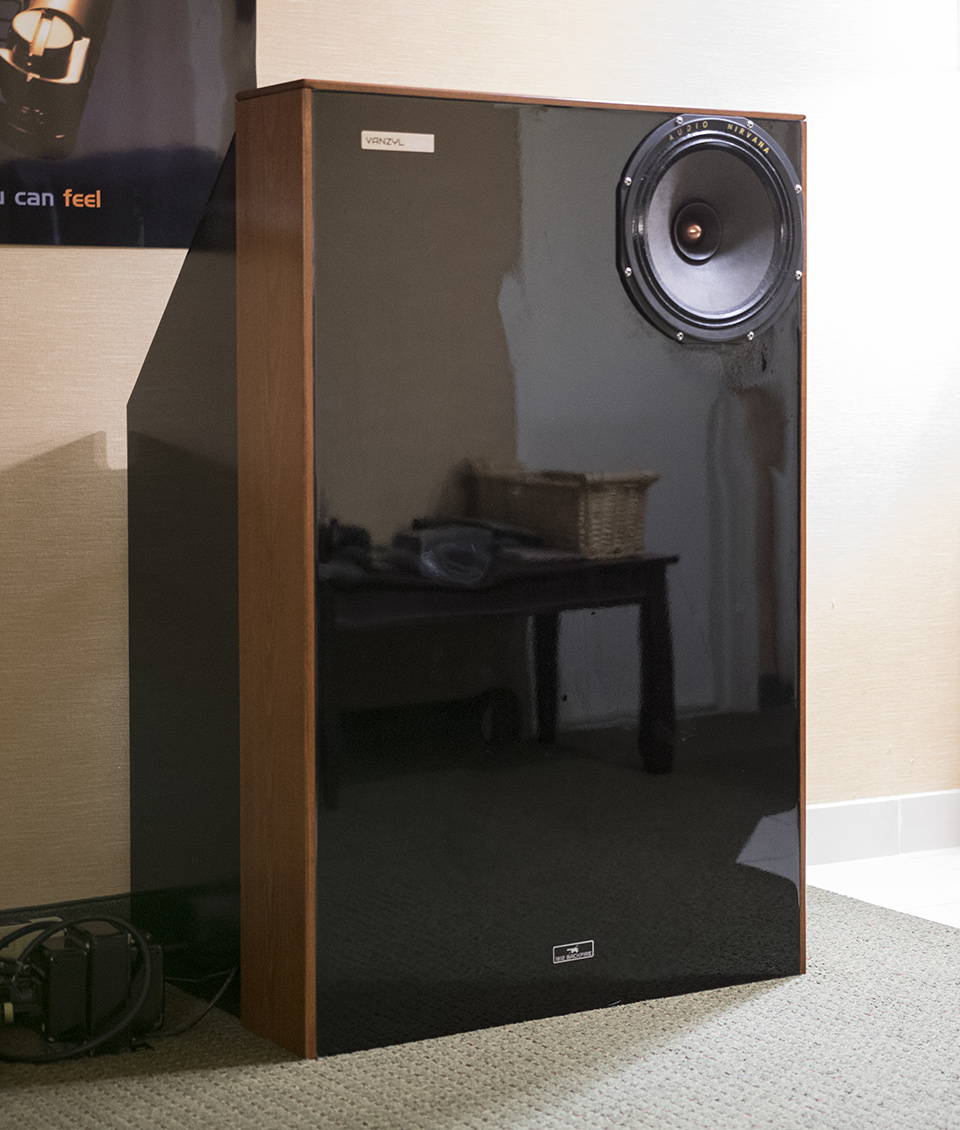
After walking into the room to see the full range drivers, I immediately went into hunting mode as I walked across the room, all the while listening for cone breakup.
Moving on and off axis, near and far snapping photos and inspecting the details - my ears were working overtime, trying to find what must be there.
We are talking about a 12 inch paper cone, so the break up would be around 1-2kHz - way more hidden than the 3-7kHz range normally found on smaller mids/woofers.
Try as I might, I could not hear it. Maybe with some extended listening I might find some hint of breakup, but the 30 minutes I spent in the room, there was no audible breakup.
Everything is not perfect though, there was a sever lack of treble in the listening position. The breakup was not audible, but the effect on directivity was clearly audible. Basically the room was too wide for the speakers, and because of the rear horn loading requiring the wall to work properly, there is no option to toe in the speakers. I tried listening directly in front of one of the speakers, to see if the treble performance was at least neutral in mono, but the quantity of treble was still too low for me to determine the quality of it. I walked away from the room thinking I'd like to give these speakers another shot in a different room.

Weirdo stuff here, the valve on the back is for releasing pressure from the rear of the driver - I'm not sure about the audible or practical use of this feature, but it sounds crazy.
Russ Sound/Usher V-601
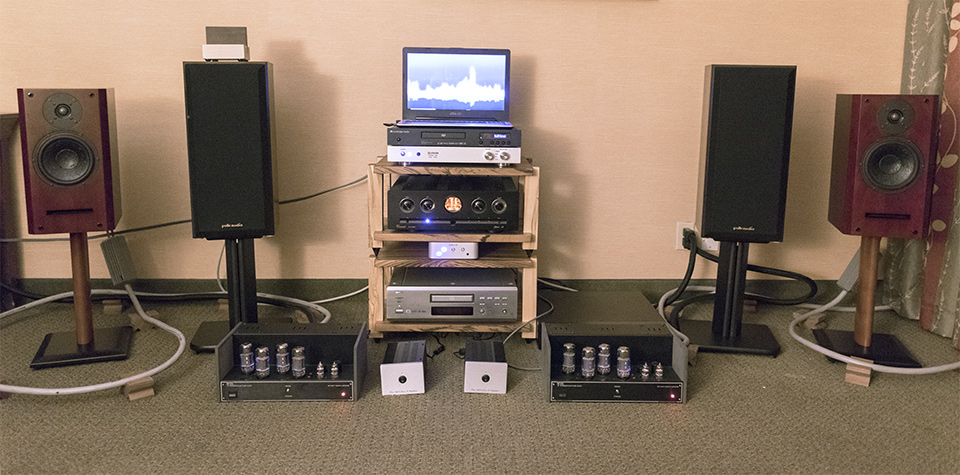
Russ is a feature of the show, a tall, lanky and heavily bearded man with a big grin and booming voice. He can usually be found drinking and smoking loudly outside the front of the hotel, engaging in friendly banter about the technical details of system design with more proficiency than his appearance would predict. If not for my habits of also drinking loudly and smoking as often as humanly possible, I would probably have missed his room. While discussing opinions about various rooms Russ thought he had me pegged, as someone whose enjoyment is tied to the measurements I take. He accused me of having no soul.
Introspecting my behavior - reviews, content, and discussions I have off and online - I can agree that I come off as a Faust like character, but I have not taken the deal with Mephisto yet.
I assured him that my soul was intact, and that I was able to enjoy music, but that was only if the system didn't sound like shit.
Up we went to settle the condition of my incorporeal facilities. A short elevator ride, and a turn of the door knob introduced me to a hidden gem of a personal system.
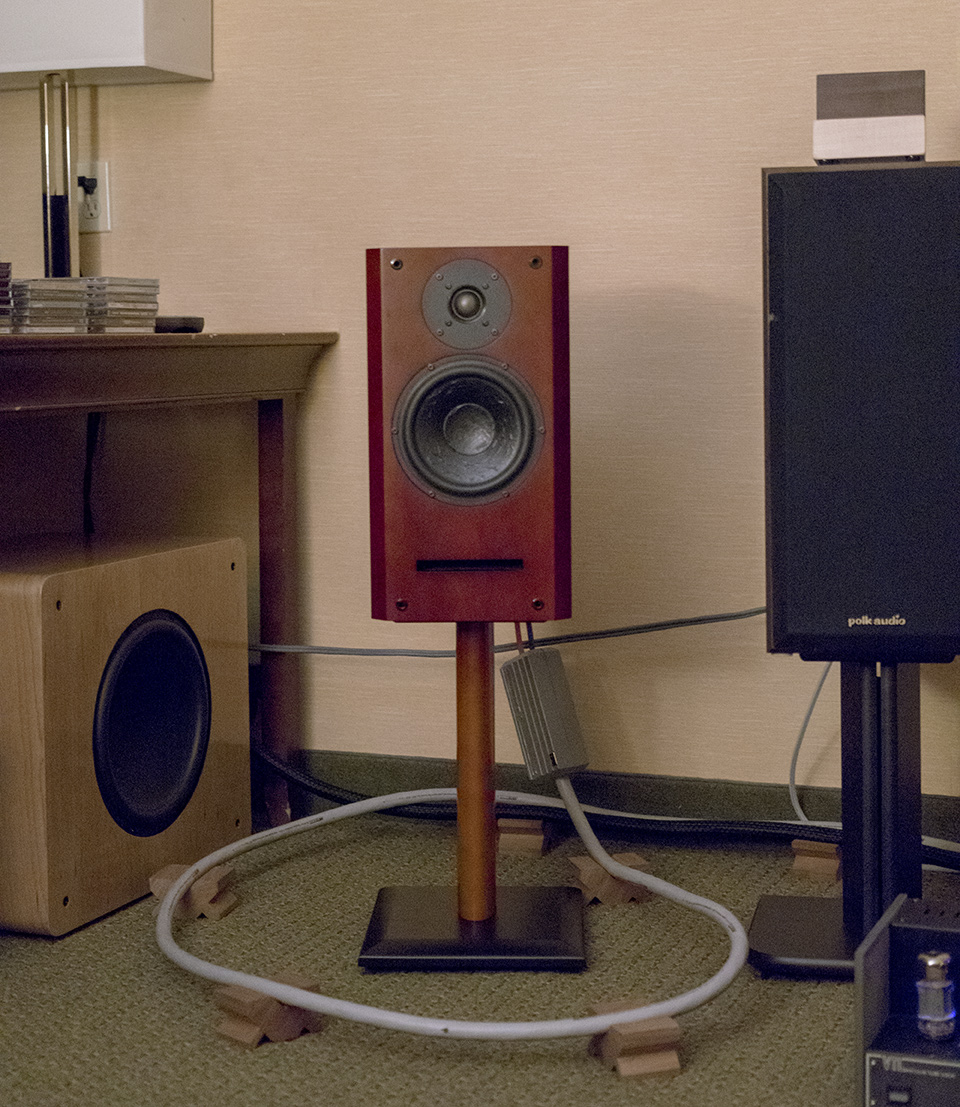
This collection of odds and ends, with nothing left untweaked - crossover component swapping cost more than the Usher speakers did, and I know that MIT wire ain't cheap either. We are talking deep levels of tweakage.
If a had lost my soul, there was enough sèance paraphernalia here to summon it to appear. With my eternal spirit on the line, I requested Earth Wind and Fire again to check out the system. After a few seconds of audio I could tell this was a pretty good system. It sounded better than the other Usher speakers at the show, and I'm assuming as a byproduct of all the tweaking, it had developed a comfortable bloat in the lower midrange without any loss in intelligibility - most similar to the Rosso Fiorentino Siena in tone. The volume level of audio, bass reproduction, lack of distortion, and smooth tone, give this system a passing grade. This setup is definitely a product of personal preference, but this encounter along with a few others at the show opened my world view to a few more paths to get good sound. After a few more beers and some other good tunes, I was assured that I did in fact still have a soul.
JWM Acoustics Alyson AML II
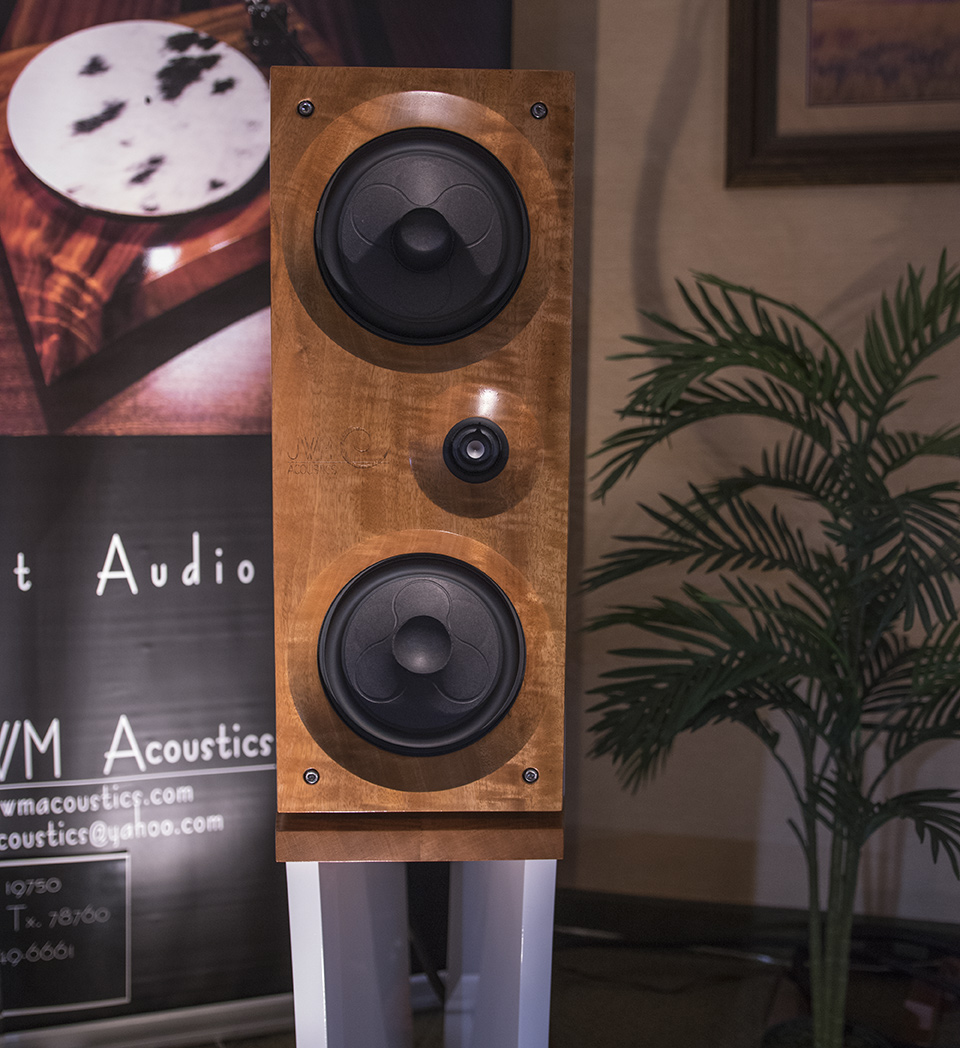
JWM Acoustics was the only company here at Lone Star that got a bad write up in my RMAF 2015 visit. A different kind of show where I hit half of the 300 rooms and gave each room 15 minutes max of my time. If I heard anything I didn't like I walk out of the room and on to the next one. The write up for JWM was limited to one sentence "This room sounded bad, it also looked like they were preparing a voodoo sacrifice with all of the tweaks." To qualify that a little bit more here, the speakers sounded forward in the upper mid, and lacked bass response one would expect from speakers their size.
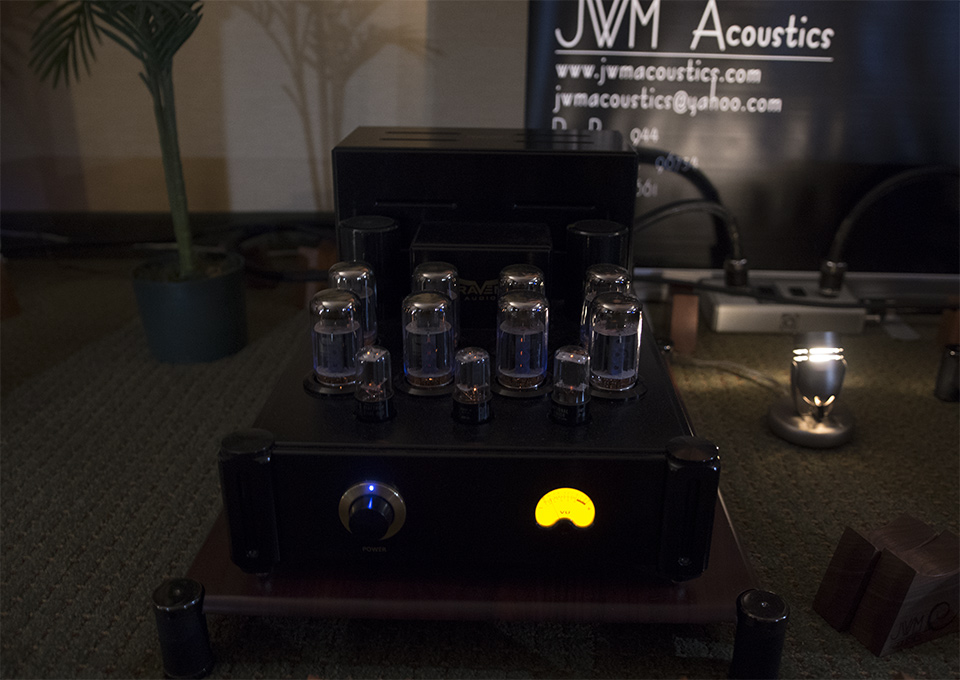
The voodoo sacrifice part of that was not far off as an accurate descriptor of this systems purpose. Late Saturday night, after finding my soul in the Russ Sound room, I ran into Steve from Stereo Clarity. I picked up a six pack of talls from my room, and we headed to see Joshua for what could be described as a primal ceremony. Upon
opening the door to the darkly lit room, We were greeted with welcome arms by Joshua who was a barefoot and welcoming host. There were already a handful of other show goers in differing states of inebriation seated, in a row facing the speaker system.
Steve and I found a seat, and the music, a lively bit jazz I'm sure most audiophiles would be able to rattle off with ease including the original pressing date of the vinyl. I'm not a jazz guy, but I did find the atmosphere made the music more interesting to my ear. The sound levels were around 90dB, but with the forward sound of the speakers, this was stupid loud. I mentioned to Joshua that some of the local Audio club members I spoke with complained about how loud his and a few other rooms were, he said plainly "Fuck'em." A sentiment that gained JWM a gold star from me. I've always been of the mind that you give the customer what you want, not the other way around. We all talked a bit, loudly over the music about different designs, other rooms, the performance of the speakers, amps, and other gear, to the background track of Ray Charles and other types of music I don't really have a firm appreciation for. Then an interesting track came on, it was a Greek remix, almost electronica in composition of Dave Brubeck's Take Five. The track was amazing, and the speakers performance with drums and horns was extremely impressive. Joshua refused to share the track with us, treating it like a sacred object that can only be heard on special occasions. Just like the company and conversation shared here, It was a special treat, and one that I'll remember.
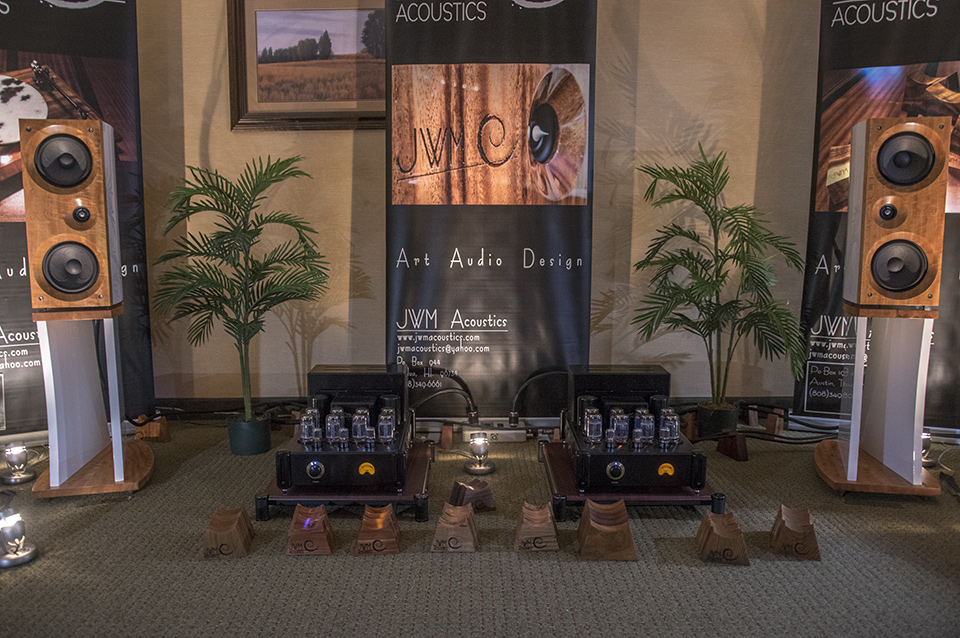
At Lone Star I got to spend much more time with the JWM Acoustics speakers, and it sounded better. There was actual bass this time from the speakers, which are a revision of the original Alyson AML's I heard at RMAF. The bass was a little uneven, but it was hard to tell it that is from the placement/room, or a product of the design. The speakers are still analytical in the midrange, no doubt a byproduct of the illuminator woofers, but I didn't hear any cone breakup or nastiness.
Side note: These speakers are definitely chick magnets - one of the only two women at the show said "Oh, this is where they keep the pretty speakers" when rounding the corner into JWM's room.
Manzanita Birdhouse
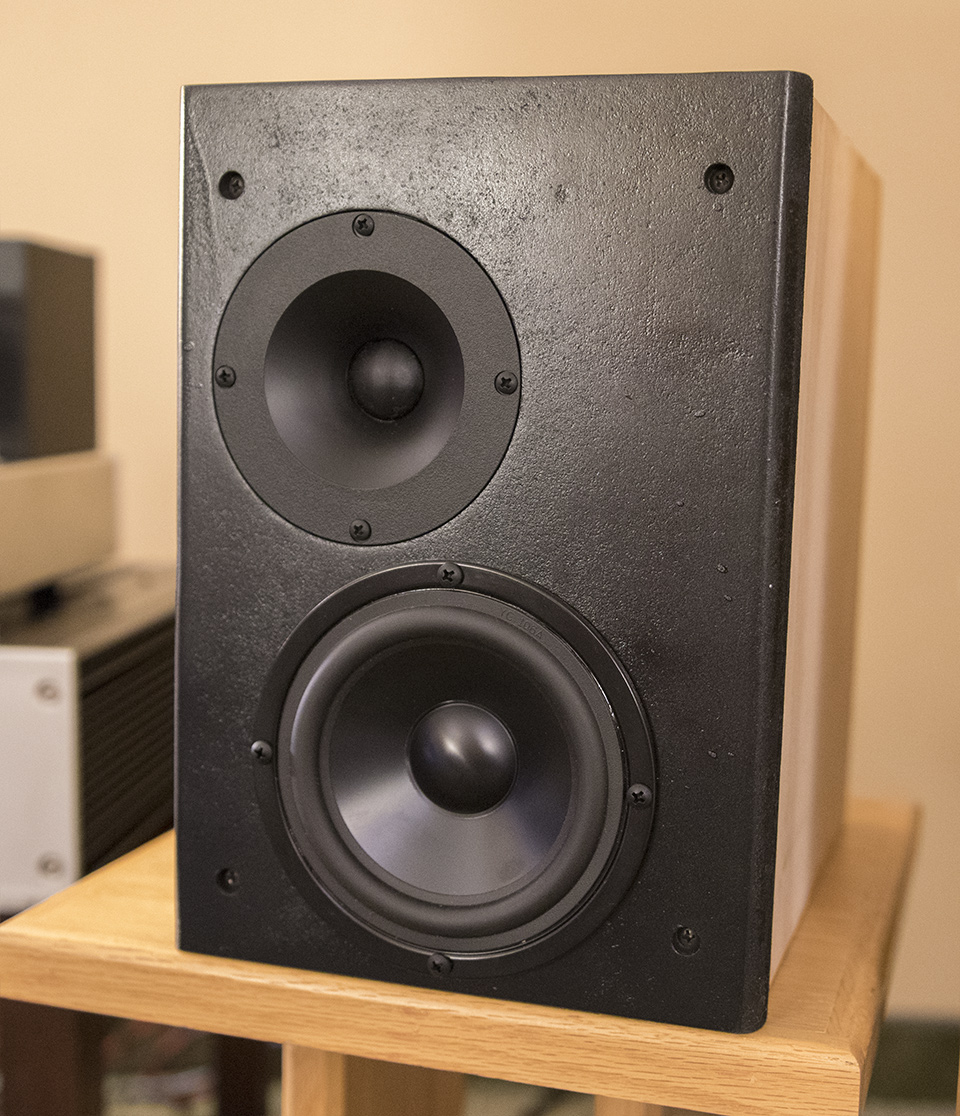
Manzantia is a boutique manufacturer, with a ton of knowledge and at least one pair of pretty good sounding speakers.
These little speakers, called the birdhouses because a neighbor of his saw the speaker cabinets with just the rear ports, and commented the those were really pretty birdhouses.
Well, the cabinet work on these speakers was a step above most birdhouses, but not as pretty as the designers who outsource their cabinet work.
Considering the odd proportions, average construction, and pretty standard drivers - it's a good thing that they sounded so good.
To put this 'good' into context, they sounded good for the show, and good enough to get a passing grade from me in a full review, although I would probably say they need a subwoofer to finish the job.
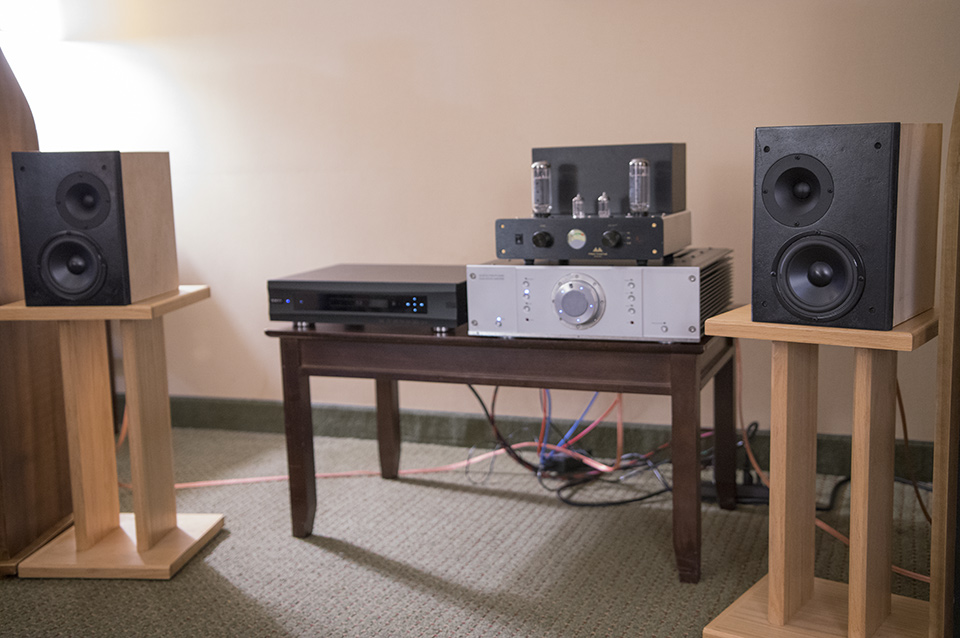
The box width, and the way the hornloading of the tweeter matches up with the edge of the cabinet is what I think makes these work so well. The crossover tuning on this was done well, and by a designer that has a good target sound in his head.
Manzanita Widow Maker 3

The Widow Maker 3 is a project still in development, the crossover parts were in the process of being tweaked, and the drivers were still being broken in. The name is dictated by the size of the speaker, something about wives killing husbands who haul oversized speakers home from audio shows.
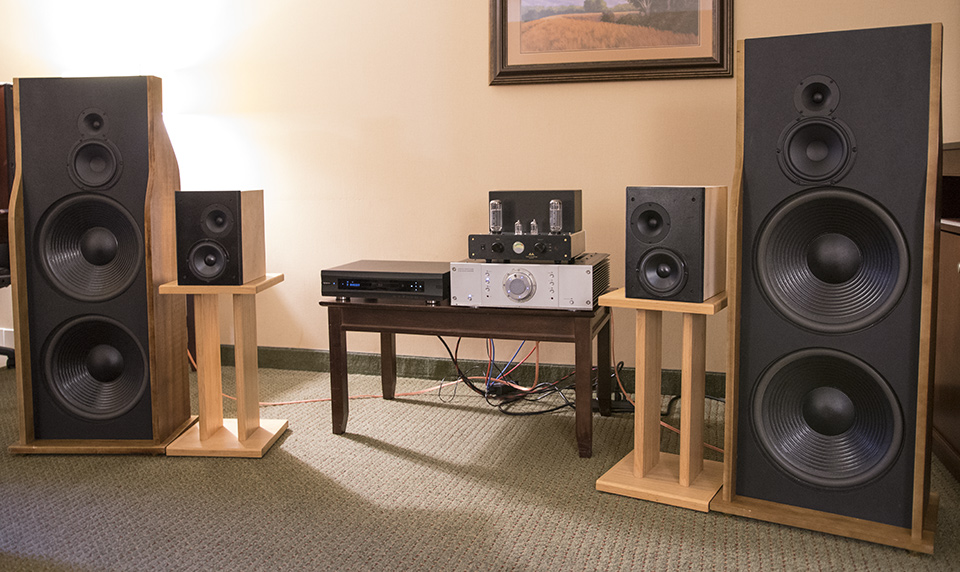
Using the same tweeter as the birdhouse, but with Peerless Midwoofer, and some $30 GRS 15 inch woofers in an open baffle setup. This speaker had the right bones to hit a stupid low price point, and maybe sound good enough to impress a few people.
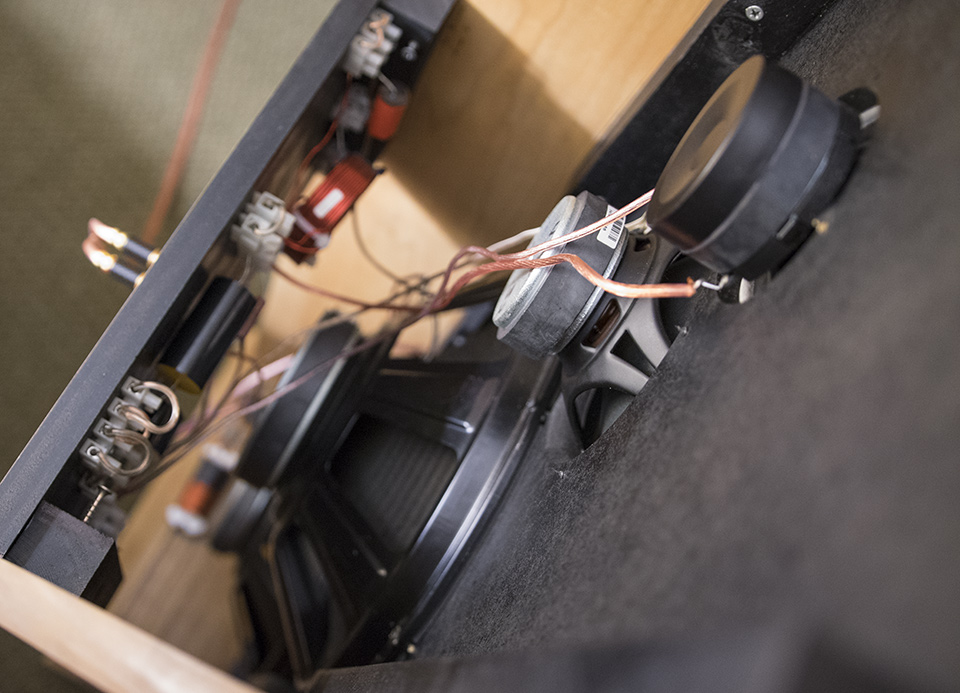
Lots of promise with this speaker. I'm really hoping that I get to hear these speakers in their final form.
Final Thoughts
My experience at Lone Star serves as a stark reminder of the past of the hobby, where it was more than just collecting shiny things, it was really about people. Not suits and sales people, but regular guys in a communal primal competition, pursuing quasi spiritual enlightenment via reproduced audio. As the corporate giants of the industry start to take less risk, cut corners for profits, and move more to Amazon friendly form factors that pack tightly on boats from China, hopefully there will be more events like Lone Star where the original spirit of the hobby is kept alive by the faithful few.
Make your pilgrimage to Lone Star Audio Fest May 3-5, 2019 in Dallas TexasHere is the hotel, call and reserve a room on the 2nd or 3rd floor if you want to exhibit
Other content you may like:
- Vanatoo Transparent One Review - Software update brings new standard of performance!
- Lone Star Audio Fest 2018 - Staying up late, drinking too much, smoking like chimneys!
- Andrew Jones goes back the be begining, ELAC B5.2 Debut 2.0 Review is up!
- New Scores for all reviewed speakers - Compare and sort for fun!
- Creative Sound Solutions DIY Solution for the high end - CSS Criton 1TD v2 review is up!
- Dayton Makes a Budget Desktop speaker with a crossover - Dayton Audio MK402 review is up!
- Smaller than small, deeper than deep - iLoud Micro Monitor review is up!
- Vanatoo's new speaker, The Transparent Zero review is up!
- SVS Prime Bookshelf Review is now available for your viewing pleasure
- ELAC A-Stock UB5 Listening Impressions are up!
- 30 years in the making, the ancient Bose 901 finally gets measured - The Bose 901 review is up!
- Lock and load, we are hitting the bottom of the barrel with both barrels - The Logitech z313 review is up!
- Bulletproof speakers... No, it's just the B&W 686 S2 Review!
- Declare independence from the British sound! - The KEF Q300 review is up!
- Recommended System Finder - Just in time for the Holidays!
- JBL LSR308 Studio Montor - Super Massive Epic Review!
- Two years after starting this site I finally get around to talking about my stereo.
- Small and cheap speakers transform into retarded and good... Micca COVO-S Review!
- AMT tweeter on a B652? The Dayton B652-AIR is reviewed for great justice!
- JBL LSR305 Studio Monitor Review!
- Zu Essence Review!

